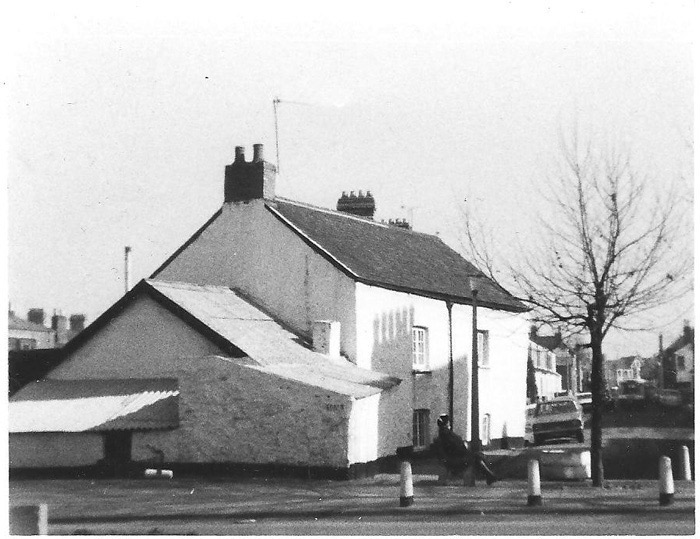 "A wonderful online resource..a series
of outstandingly good and carefully researched articles on the history of the
area" - Who Do You Think You Are magazine?
Here
are our pages on local Grangetown history. We hope to add more features
and would welcome any stories, articles, memories or photographs. Please
email
Here is Grangetown
history from the early days to the area's growth in the Victorian age
to the first few decades of the 20th century.
Thanks to Peter Ranson and the Grangetown Local History Society - www.grangetownhistory.co.uk - for
their help, especially with photographs and also to those members and others
at home and abroad who have added memories and stories. If there are any copyright
issues we are unaware of, please let us know and we will gladly give a credit/amend
etc.
|

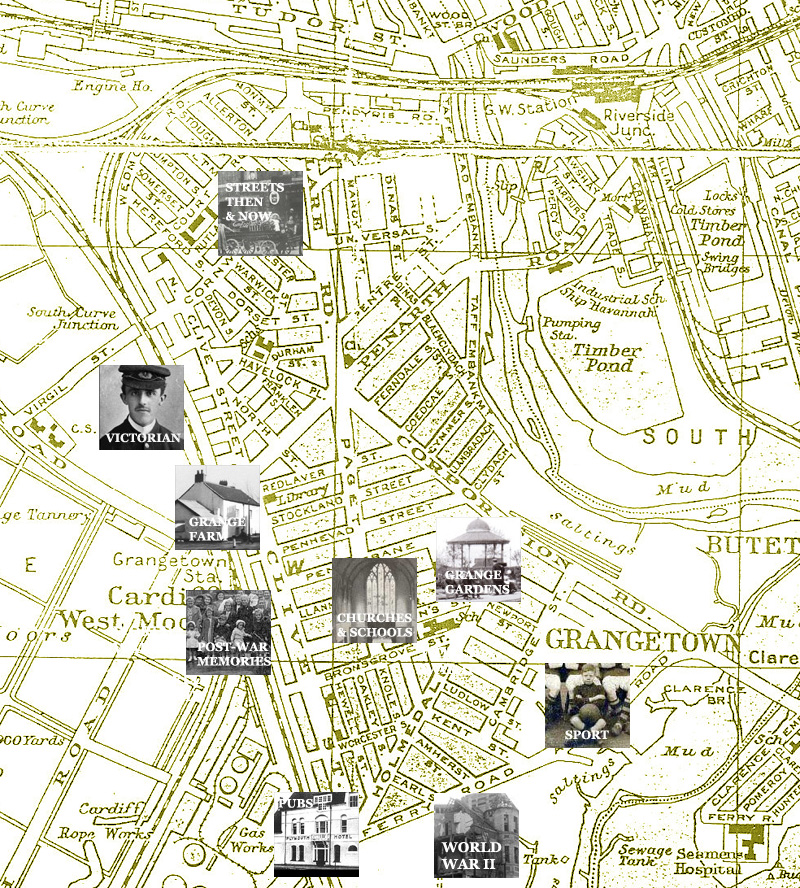
Go
to 1930s and Second World War
Post-war
1950s and schools memories
Sport
and Transport and the history of Grange Gardens and local recreation
Churches
and schools and also Pubs
and clubs and
the history Of Grange Farm.
Grangetown industry - from iron, rope, gas to cigars
Victorian Grangetown politicians
Streets origins
and Census (in progress)
Photos of Grangetown then and now

Go
to Grangetown World War I Centenary - 1914-2014, Online Memorial


'Our
grange near the town of Kaerdiff'
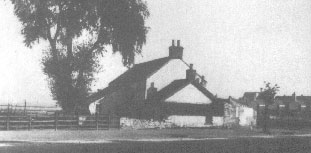

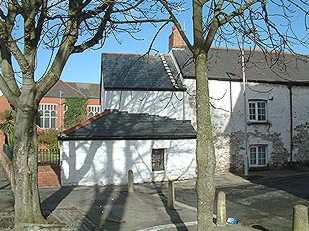
Grange Farm in the 1890s, in the 1970s and today.
Grangetown's oldest surviving building - Grange Farm - is a reminder that
both the building and the area which took its name can be traced back 800 years
to medieval times.
The Cistercian monks of Margam Abbey (near modern day Port Talbot) established
a grange to farm the land in the early 13th century, off what is modern day
Clive Street. It was an outpost, and legend has it that they were sent there
as penance for drinking and gambling! Moor Grange was reputedly built at some
time between 1193 and 1218 and ran to 100 acres. The monks had been granted
land at Margam in the mid 12th century, with the abbey founded with the help
of Robert, son of King Henry I and by the end of the century Henry Bishop of
Llandaff had granted to the abbey all land nearby "in more de Kardif," in return
for an annual rent.
According to a short history of Grange Farm, put together from local records
in the 1940s by J Cleary Martin, details of the land emerge again in 1329 in
the reign of Edward III. Noblemen sitting at a court at Cardiff Castle heard
a land dispute involving the Abbot of Margam and the recently departed Lord
of Cardiff, Gilbert de Clare, killed at Bannockburn. The abbot had a dispute
with Clare over land at Kenfig (near modern day Bridgend) but the judgement
in the monks' favour also mentions "the grange on the moor near Kardif."
The Grange of Luquyth (Leckwith) by the end of the 15th century had 400 sheep
and 100 cattle and the abbey leased out the farm through Jasper Tudor (Henry
VII's brother) to Griffith ap Meuric. The records also showed 7s 1d was paid
for taking "17 loads of hay from the abbot's Grange" to the lord in
Cardiff.
Lewis ap Richard was the last farmer to lease from the abbey. His agreement
from the monks stated - "know ye that we have delivered to Lewis ap Richard,
esquire, our grange near the town of Kaerdiff, commonly called More Grange,
with the end term of 90 years. " £6 13s and 4d was payable on the feast
of the Anunciation, along with 4s a year to the Bishop of Llandaff and two acres
of hay to the abbot. Lewis was also responsible "to suitably repair and
maintain" the grange, house, sea walls, weirs, ditches and fences.
But with the dissolution of the monastries by Henry VIII, Abbot John of Margam
was pensioned off and the farm passed to the Lewis family (of Van, Caerphilly)
in 1537. In 1547, Edward Llewelyns was farmer with the same rent Lewis ap Richard
had paid. By 1595, rent had dropped to 44 shillings a year, showing the farm
had declined somewhat - "messuage (house and outbuildings), one barn,
one parcel of land, meadow and pasture called the Graing de Moore."
By 1638, "the manor land they called the Grange Marshes," was 300
acres, each with a yearly value of 4d. It was "bounded by the higher lands
of Penarth in the west, the Severne shore on the south, and the River Tave on
the east, and the common lands of Leckwith in the north."
Forward a couple of centuries and the land passes onto the Earl of Plymouth
and a long association with one family. The Morgans started running the farm
for the Plymouth estate in about 1835.
By 1881, we find the 120-acre dairy farm being run by the Morgan's third daughter
Ann and husband Samuel Burford. The Grange Dairy provided milk locally, while
the farm also kept animals and a coal business. Not long before her death, Doris
Burford, who still lived at the farm in 1987 recalled her 78 years born and
bred there. As a girl, she got up at 4am to start the milk round, first in a
horse and cart, eventually in a van. "It used to be dark getting the horse out
of the stable - I was a bit frightened," she recalled to the Echo. "We
used to sell the milk straight from the shed - now a garage - until the rules
came in that it had to be pasteurised."
"Everyone would come to the house - it was the only one for miles. It
used to be the life and soul of the place," said Doris. The farm was taken
over by her nephew and at the turn of the century was bought by new owners,
who have painstakingly restored it and discovered some more original features
in recent years.
You can read a fuller account here in
our History Of Grange Farm.
Despite the terraced streets built on its old land,
the farm building still survives today, with some original features inside.
It is Grade II listed. The Victorian library building, preserved as converted
flats in 2008, is a pleasant neighbour.

Full steam ahead for king coal and
Cardiff
Cardiff was a fairly insignificant market town until the 19th century. Its
population was barely 1,900 - and at the start of the industrial revolution,
it was still dwarfed by the iron town of Merthyr Tydfil and copper town Swansea.
Under successive Marquesses of Bute, who inherited estates and land, Cardiff's
importance grew as its docks and railways were built and it became the world's
pre-eminent port for coal for steam ships. The population rapidly grew to 165,000
by 1901, with 20,000 new homes built in the last two decades of the Victorian
age.
It was nearly "Clivetown"
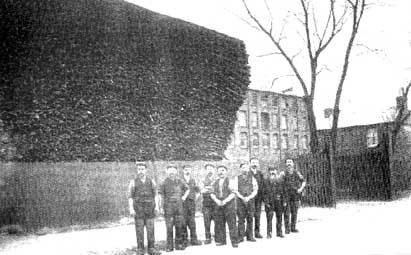
The name "Grangetown" was bestowed by Baroness Harriet Windsor-Clive, daughter
of the Earl of Plymouth, the owner of Grange Farm and other local land from
the Plymouth estates on which much of the later suburb was developed. In 1857,
it had been suggested that the new area be named "Clivetown" after the family
name of her late husband Robert Clive, the MP and son of "Clive of India."
But the Baroness would have none of it. She wrote: "The subject of a
name for the new Town we may now expect to see spring up on the Grange and he
(son Robert Windsor-Clive) is more disposed that it should bear the name of
the locality rather than that of 'Clive'. 'Grangetown'would be very suitable
for various reasons and is I think the best - the name of 'Clive'may appear
for the principal street."
Early industry
In the first few decades of the 19th century,
Grangetown would have been a few houses but it also had pockets of industry,
which grew up in the late 1850s and 1860s. These include a tannery,
a rope works, brick yard, gas works and a short-lived iron works. Others included
a candle works. Later, the Freeman's cigar factory became a significant employer
of women. You can read about all these industries here.
First came the railway, then rapid growth
The railway was a predecessor of today's suburb and along with the river Taff
defines its boundary. Some say this enclosure helps modern Grangetown retain
something of its old "village" atmosphere.
The village of Lower Grangetown was first to grow (with Clive Street,
Holmesdale Street, Kent Street, Worcester St, Amherst, Bromsgrove, Knole, Sevenoaks
and Hewell Streets) and was well established between the 1860s and 1880s. The
Grange National School opened in 1864. A report in the Cardiff Times in
1865 found it was not perfect in places. "The police here, with their inspector
from Llandaff, seem to be most active in compelling the keepers of pigs and donkeys
to look to the state of their dwellings, where it appears from the police reports,
pigs, donkeys, cows, children and chickens have been in the habit of messing together,
in one dwelling, and even in the same room. The proprietors in some cases are
finishing their houses; others are pulling theirs down."
 Auctioneer Thomas Clarke said he first knew Grangetown in 1859 "when it was
a dismal swamp and morass, given even the village missionary, the water wagtail
and the postman who passed it on his way to the ferry." The scene, however,
by 1873 offered a great contrast and he argued it was "capable of great
development in the future."
Auctioneer Thomas Clarke said he first knew Grangetown in 1859 "when it was
a dismal swamp and morass, given even the village missionary, the water wagtail
and the postman who passed it on his way to the ferry." The scene, however,
by 1873 offered a great contrast and he argued it was "capable of great
development in the future."
An Estate Act of 1857 had allowed Lady Windsor to mortgage farmland to raise
money for new roads and what was regarded as the city's best drainage and sewage
system. Long leases on land were sold to a patchwork of builders and speculators
to develop new housing for workers. There was originally hope of developing
Grangetown as an industrial area, with workers living close by, but this never
really took off and it became a commuter area for the Docks. M J Daunton's study
of the Windsor records between 1857 and 1875 found that Grangetown's progress
was hit by a city-wide housing slump at one point, with the developments taking
a long time to break even, with suitable returns for the builders and landlords.
He said it was piecemeal progress involving "many hands over many years." Between
1873-74, he lists 10 different builders in Holmesdale Street and Amherst Street
alone.

Grangetown Local History society member Ray Noyes has published a book Victorian Grangetown which looks at the planning, engineering and building of Lower Grangetown. Above is an early sketch map of Lower Grange - and you can see the names of
the different builders for the houses, including John Salt quite prominent.
He left £3,000 when he died in 1876, aged 45. He lived in a house, Tower
Grange, "near the bridge" and Grangetown iron works. There's also
builders like Abraham Lane (1826-1870). Click image for full size.
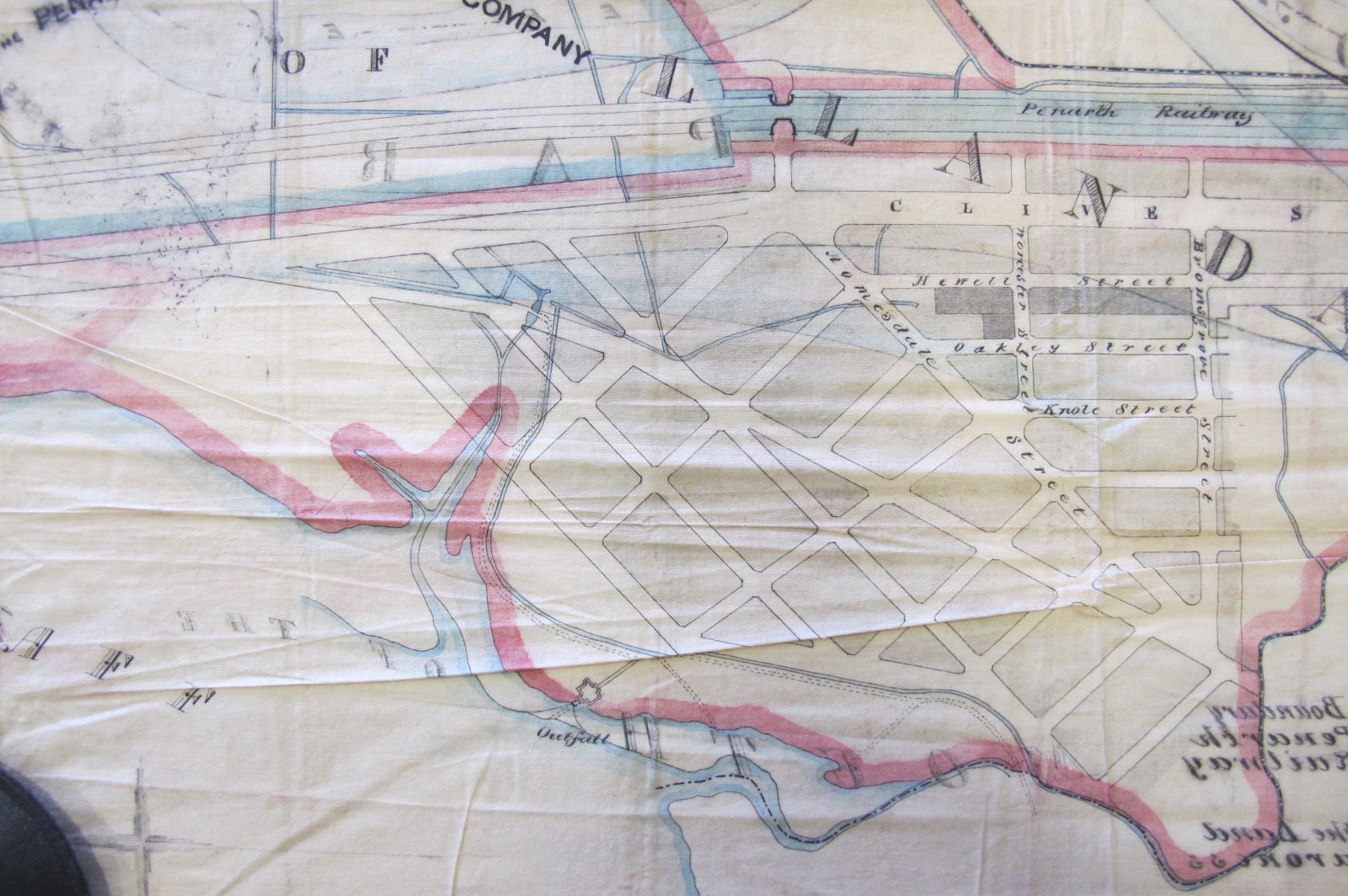
This is interesting because it shows early plans to build streets beyond
Ferry Road and towards the foreshore (to the bottom left). The biggest problems
facing builders in Grangetown were flooding and the marshy land - so these streets
were not developed. Click image for full size.
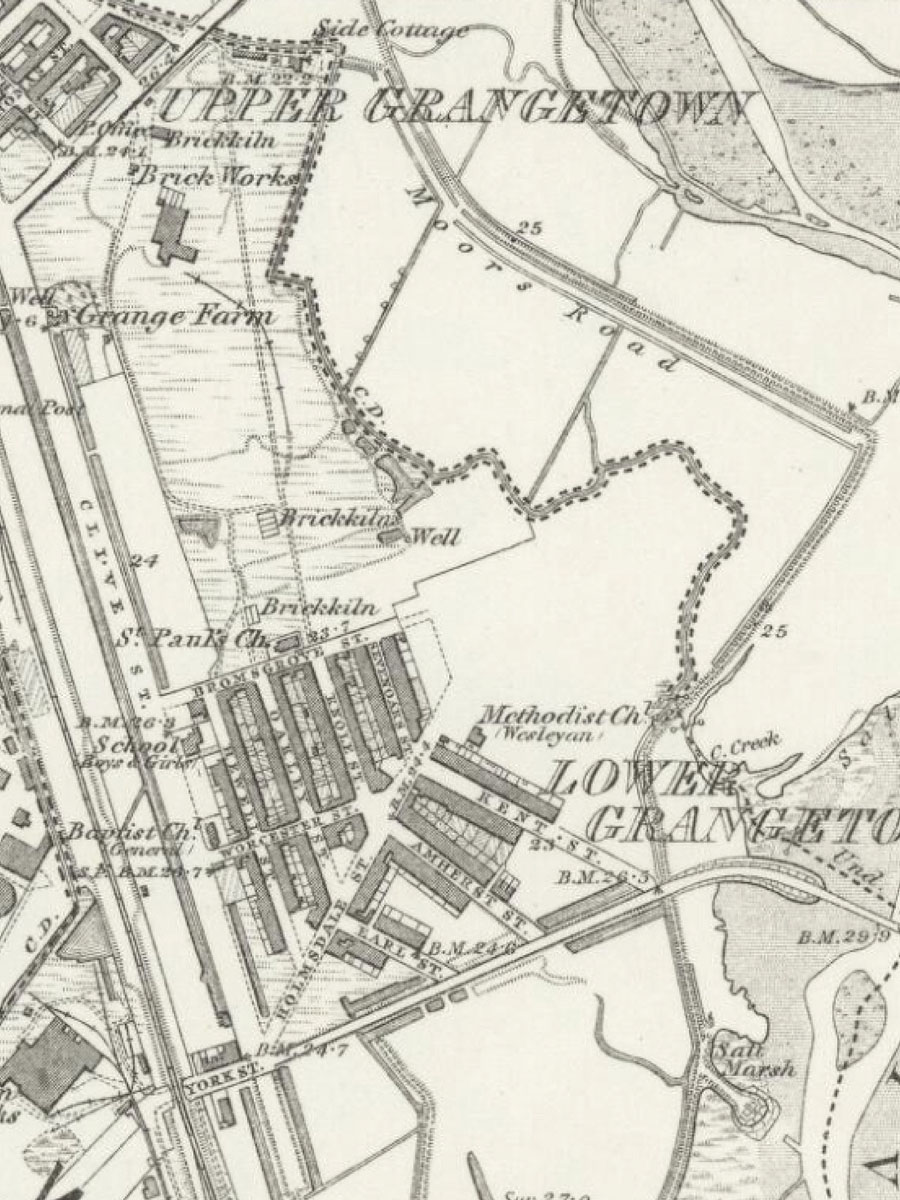
This map from the 1870s shows the baptist church in Clive Street and off
Penarth Road, significantly the brick works - between modern Redlaver Street
and North Street. The ground was perfect for "marl" clay. At its height
in the late 1860s, the works turned out 1.5m bricks a year. Another brick works
was located between Penarth Road and modern day Clare Road - in the Taff Mead
area. Click image for full size.
Upper Grangetown - known for years too as Saltmead - was slower to develop.
A few streets, chiefly North Street and Thomas Street off Penarth Road, were
built by the start of the 1860s and home to many Irish immigrants. The majority
of streets, off Cornwall Street and North Clive Street and close to the railway,
were constructed for the thousands of migrant workers in the late 1880s and
1890s, as Cardiff expanded. For years, what is now Saltmead was just moorland.
The Cardiff Times reported Canton residents petitioning in 1865 for a
new road to link where Baroness Windsor's new road ended at North Clive Street,
due to the difficulties in walking the direct route across the moor in winter
- they had to walk back home from the docks via the town centre. "It was
very unpleasant now to go to Grangetown across the moors and working people
and their operatives were driven to Roath instead," said the rector of
Canton, Rev Vincent Soulez.
There was pockets of poverty too, already by the mid to late 1860s. In 1867
in the town's poor relief books, Bridget Foley, 32, with two children, was described
as "destitute" and received four shillings and five pence a week, as well as
food and milk; Thomas Allen, 40, was widower and father-of-four who was too
ill to work - as well as seven shillings a week in relief, he received food,
meat and 14 shillings to meet funeral expenses; Mary Collins, 34, had been deserted
with five children and was given five shillings a week.
These two distinct areas of Grangetown were linked by Clive Street and crossed
by Penarth Road. The old Moors Road (later Clare and Corporation Roads), ran
parallel to the Taff although not all the way to Butetown in the mid 1880s.

In 1875, Grangetown became a Cardiff suburb,
although there were still fields separating it from the town centre. The two
parts of Grange were still distinct - Saltmead in the north, named after the
salty marshland; and lower Grange to the south.
Grangetown, prone to flooding
The Ely burst its banks after continual rain one Thursday morning on July 15th 1875 causing "widespread devastation" in Canton and Upper Grangetown. The Cardiff Times reported it vividly and also underlined how semi-rural Grangetown still was at this time: "The Grange, principally occupied by working men and their families, is completely surrounded by water to the depths of at least four feet, the highway to Penarth at seven o'clock in the evening being only passable to vehicles and horsemen. On the right of the highway the large field extending northward to the Great Western Railway resembles an inland lake, varying in depth from 4-7ft, and the water is just beginning to overflow the roadway opposite to the Grange Hotel.
"The streets which seem to be in imminent danger of being undermined by the swiftly rising waters are Thomas and Rosemary Street. The houses appear to be toppling over. Most of the furniture has been removed from the upper rooms, but a number of sick persons could not be removed in the ordinary way. A number of young men volunteered to procure a boat from the adjoining river Taff, and had succeeded in getting it partly on the way when darkness set in.
"Another group of men were cutting through the bank at the bottom of a field on the left side of the roadway, in order to admit if the water flowing into the Taff, In this they were successful to a considerable extent. About 30 head of cattle were saved from the adjoining field just before the water rushed through the gap in tremendous volume. The cutting of this gap reduced a portion of the large body of water from John's brick yard adjoining, and prevented the overflow on the other side from sweeping down in Lower Grangetown. The Taff Vale Railway, carried cross country by a high tip or embankment, has by its massive proportions saved this suburb from being at once twept away. Ascending this embankment and looking westward, the whole country for miles on each side of the Ely is under water.
"Floating hay-stacks thickly dot the surface, as well as hay-cocks of smaller size. Looking again to the eastward, through the cross streets of the Upper Grange, all kinds of vehicles are in requisition, getting loaded from the upper windows of the houses facing the Great Western Railway, partly dragging them and partly swimming. Some were fortunlate in reaching the main road, others, coming in contact with submerged goods in turning the corners of the streets, threw their goods into the foaming and eddying torrents - drivers, men and horses.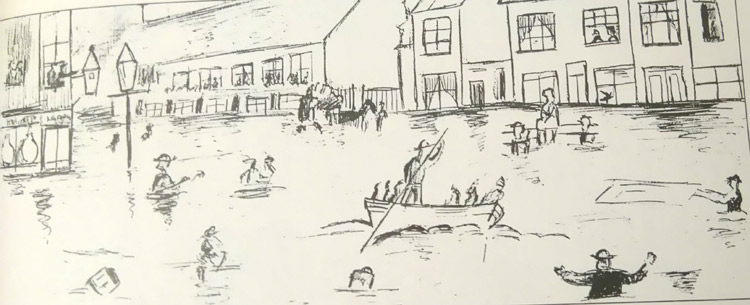
Hairdresser Sam Thomas drew this sketch of flooding in Ludlow Street in October 1883.
The report continued: "Willing hands were not wanting to cut the traces of the horses, and help the men, who otherwise would have been carried away and drowned. Scores of men we saw carrying their little ones towards Cardiff, and two men we noticed had what appeared to be aged females in their strong arms, carefully wrapped up in coverlets and blankets.
"Our reporter, who visited Upper Grange at 11pm, says the left side of the main roadway to Penarth opposite this place is completely submerged to an equal extent with the meadow, lands and fields on the opposite side, the water having increased fully three feet. The only drain pipe, said to be nearly nine inches in diameter, the entrance being opposite the Grange Hotel, is choked up with hay swept into it from the adjoining field."
The Cardiff Times concluded that there was "great anxiety" for the safety of the tenements "at the rear of the village" towards the Great Western Railway, as the "full force of the enormous weight of water is swaying them inwards towards the remaining buildings. Some people are reported missing, bnt it is expected that when the bustle is over they will be found."
Then on the evening of October 17th 1883, another high tide - with gale-force winds - saw water burst through the sea dyke opposite Kent Street, reaching a height of between 4ft and 7ft. A man rushed into the harvest thanksgiving service in Ludlow Street shouting "the flood is coming," Sam Thomas recalled. The preacher reportedly urged calm, before promptly fainting!
Flood water almost reached the first floors of houses, while people were wading up to their waists. Livestock was lost, with the whole area said to resemble a lake. Newspaper reports from the time give a long list of shopkeepers in Holmesdale Street who sustained losses - from shoemakers to grocers, nine pubs were affected including the landlord of The Plymouth (in Clive Street) who claimed he was down £200 after water flooded his cellar. Mr Edwards the grocer in Oakley Street lost £100 worth of stock. A third of homes lost their back walls between the streets. Those living in Kent Street were said to have suffered the greatest loss in terms of "spoilt furniture."
Schoolmaster James Buck - a small man - was carried to his home through the torrent by a visiting preacher - and much taller man - at Windsor baptist hall in Holmesdale Street.
Alfred Fish, a teenager during the flood, said Grangetown people were "somewhat superstitious" and some had read Mother Shepton's Prophetic Papers, which foretold the end of the world in 1881. "I remember as a lad how terrified the people were as they looked at the sky - black and streaked with white patches..in the early evening the water burst through the tide bank and rushed down the streets."
"I was caught up in the flood, about 12 houses from my home," he recalled as an old man in the 1950s. "I was soon up to my waist in water but presently a tall, strong woman named Mrs Perrott rushed into the middle of the street, picked me up and carried me into her house, took off my wet clothes and put me to bed. She was a customer of my mother (Sarah), who kept the grocery shop on the corner of Sevenoaks Street."
The waters had receded two days later when Lord and Lady Windsor visited to survey the damage.
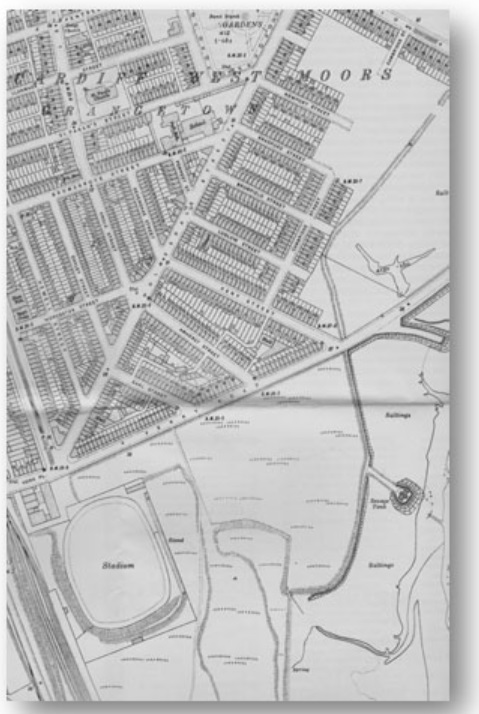
The flood also hit the old Iron Room church, which was also holding its annual harvest festival service.
"We were assembled in church - a packed congregation - for the annual harvest thanksgiving service," recalled a bell-ringer 20 years later. "Presently we heard a commotion at the doors. A wild-eyed man had come to seek his daughter, for he verily believed that the whole populace of the Grange were in danger of their lives. Before anything could be done the water came percolating through the cracks in the flooring. Many sped from the building into the streets, where the water was rushing hither and thither and rising higher and higher as the tide rose."
"I myself and other youngsters amused ourselves by catching shrimps and minnows - a strange pastime in church. Meanwhile, the hymn For Those In Peril On The Sea was given out, and considering that by this time most of the adults in that congregation thought that they themselves were in dire peril, for the water was still rising steadily, they sang those thrilling words with a calmness that spoke of brave and trusting hearts within."
A few days later, Henry Marshall, a builder from Kent Street, wrote: "Having visited about 190 houses in Lower Grange, and the greatest portion of the houses in Upper Grange, I can bear testimony as to the disastrous results of the flood. The result is that the homes of the working men are to a great extent broken up, in most cases the best of the furniture being entirely spoiled. In many houses the piano or harmonium has gone to pieces, and in nearly every house the week's provisions and a large proportion of wearing apparel have been rendered useless, so that many families are left quite destitute, and are also suffering much from the cold and damp that follows such a flood, not having the means at their disposal to get coals etc, to dry their things and warm themselves."
Mr Marshall, along with local councillors, was one of those involved in raising awareness of the issues with town officials. Afterwards, damage was estimated at around £3,000 while £540 was collected in donations within a few days through public subscription, including from shipowners and other businessmen. There were also calls for the embankment and sea wall to be raised.
A system of clay banks or dykes (on the 1883 map above left) was not enough to solve the problem when either the River Taff or Ely rose to exceptional heights at high tide. It would be a century before the flood defences were adequate - while the building of the Cardiff Bay Barrage also helped reduce major incidents.
The biggest spurt in building came in the 1880s and 1890s and by 1901, the
suburb had a population of 17,000 - effectively the same as it is today.
The city's most prominent and grandest builders of the period were Grangetown-based,
E Turner and Sons in Havelock Place. As well as homes, schools and churches
across Cardiff, they were responsible for City Hall and Civic Centre. The company
remained there until 1993, when they moved to Cathedral Road and the offices
and cottages were demolished for new housing.
|
1871-1878: Disease and distress
 The
north of Grangetown in particular had strong Irish and Catholic links. The
census of 1871 for Thomas Street shows us a number of Irish immigrants,
who'd settled with their families, many of them labourers with work in the
developing town. Typical is Thomas Fitzgerald, 45, a labourer with his wife
and seven children, all born locally. Neighbours include Ryans and Donovans.
There are also some brickmakers - which perhaps would tally with the brickworks
in Sloper Road. There's a pub at No 22 - The Penarth Dock run by Christopher
Griffith, 37, unusually, a Cardiff native, who lived there with his Swansea-born
wife and four young daughters. Another pub, the Grange Inn in Francis Terrace
first appears in the '61 census, run by a Daniel Francis. By 1871 it is
run by a widow from Durham. Living at 67 Francis Street (it was later renamed
Franklen Street in the 1890s, while there is also a Frances Street in Butetown,
just to confuse you!) are three families brought up in Cardiff and headed
by Irish-born labourers, John Pat Moricy, 45, his wife Mary and their six
children, aged from one to 20 - including 14-year-old Patrick, already a
labourer; John and Alice Cronin also had six children and James O'Brien
and his three young children. The
north of Grangetown in particular had strong Irish and Catholic links. The
census of 1871 for Thomas Street shows us a number of Irish immigrants,
who'd settled with their families, many of them labourers with work in the
developing town. Typical is Thomas Fitzgerald, 45, a labourer with his wife
and seven children, all born locally. Neighbours include Ryans and Donovans.
There are also some brickmakers - which perhaps would tally with the brickworks
in Sloper Road. There's a pub at No 22 - The Penarth Dock run by Christopher
Griffith, 37, unusually, a Cardiff native, who lived there with his Swansea-born
wife and four young daughters. Another pub, the Grange Inn in Francis Terrace
first appears in the '61 census, run by a Daniel Francis. By 1871 it is
run by a widow from Durham. Living at 67 Francis Street (it was later renamed
Franklen Street in the 1890s, while there is also a Frances Street in Butetown,
just to confuse you!) are three families brought up in Cardiff and headed
by Irish-born labourers, John Pat Moricy, 45, his wife Mary and their six
children, aged from one to 20 - including 14-year-old Patrick, already a
labourer; John and Alice Cronin also had six children and James O'Brien
and his three young children.
To give us an idea of some of the conditions is this report from September
1873. Eleven householders were summonsed to court for continual overcrowding
in their properties. Magistrates were told that the area was thickly populated
and typhoid was spreading, with seven cases reported recently. The Western
Mail report doesn't name the streets, only giving the area as Upper
Grangetown. The censuses puts the families in the Thomas Street, Havelock
Street and Rosemary Street areas. Thomas Donahue was found to have 18
people living in his three-bedroomed house, which was deemed fit for six.
Cornelius Driscoll had 11 in his similar-sized property. Michael Mahony,
his wife and five children shared their house with another seven people
- with the home only fit for half that number. The Western Mail reports
that the inspector when he visited Patrick Morris' house found three families,
of 18 people, with every room used as a bedroom. "The place was so foul
I could hardly enter it." Jeremiah Regan had a household of 14, including
his wife and eight children.
In November of that year, the Cardiff Sanitary Committee looked at Upper
Grangetown, where 59 cases of typhoid were reported, three of them fatal.
"This serious outbreak of a dreadful malady is attributed to the filthy
state of the habitation of the streets," reported the Mail, and it was
decided to apply to the Local Government Board to obtain powers of an
urban sanitary authority to make improvements. Grangetown was lying outside
Cardiff, and bringing it in as an official suburb would at least improve
conditions in terms of sewerage and drainage.
In 1878, with economic problems in the south Wales valleys acute - many
mines shut or on short time - and even Cardiff "suffering the pinch
of poverty after three years depression", charitable collections,
poor relief and soup kitchens were springing up for struggling working
families. The Western Mail noted however:
"It's somewhat remarkable, however, that no public movement
has been set on foot for the relief of the people of Grangetown. Here, the
inhabitants seem to be in greater want than in other parts of the borough.
The iron works having been closed, many out of work as a natural consequence,
and poverty is compelling a number of people to adopt all sorts of measures
for obtaining some kind of livelihood."
Later in the year, the paper found several people from Grangetown using
the soup kitchen set up on the corner of St Mary Street and Penarth Road..."their
wants being of an extreme character. A few casual inquiries in that neighbourhood
led the manager (of the soup kitchen, Theophilus Jones) to believe that
a vast amount of distress exists there."
I came across quite an interesting account of the end of the 19th century
in a St Patrick's parish magazine, dated from 1948. In it, C Sexton recalls
seeing in the new century at a special midnight mass. "We were all glad
to see the old century go. Times had been hard, there had been strikes
and unemployment and in the fall of 1899, we had started the South African
war that was to drag on for the next three years.
"In those days we had no electricity, very few houses had gas, the good
oil lamps, many of them with beautiful shades were in most use. I saw
the first electric car driven from the Clare Road sheds in 1901. In those
days, Solly Andrews' horse-driven tram cars and buses were the means of
transport...very few houses had baths and hot water."
The article also recalls as well as theatre and music hall in town, locally there were two concerts a year at St Patrick's school rooms - including an Irish concert on St Patrick's Day. Father Brady would also give a lantern lecture on his trips to Rome.
The writer also said it was still a few years before Grangetown library opened, and children relied on teacher Mrs Butler's own small collection of books, including favourites like Jules Verne.
Possibly proving that things come around, writing in 1948 - just after
the war years - it was noted: "One thing you do not see in these days,
but were seen frequently then were the number of drunken folk about at
closing time, Saturday nights and when a big football match was on." Shops
were also open until about 8pm every day, and Fridays and Saturdays untl
9, 10 or 11. Pubs were open at 6 or 7 in the morning, until 11pm at night
- midnight on Saturdays.
The old Thomas Street was demolished in late 1967 and new housing replaced
it. Madras Street disappeared to make way for St Patrick's School.
Some lived like pigs
in Grangetown- 145 years ago
"The police
here, with their inspector from Llandaff, seem to be most active
in compelling the keepers of pigs and donkeys to look to the state
of their dwellings, where it appears from the police reports, pigs,
donkeys, cows, children and chickens have been in the habit of messing
together, in one dwelling, and even in the same room. The proprietors
in some cases are finishing their houses; others are pulling theirs
down." Report from Grangetown, in the Cardiff Times, February
1866.
1871: A swindler passes through
He appears to be something of a rogue and a conman, but with every great
innovator and entrepreneur in Victorian Britain, there was also on opportunity
for deception by a host of shady characters. Prussian industrial chemist/engineer
Peter Kagenbusch, 56,passed through Grangetown in 1871 and took a widow
and a publican for a ride. He's listed in the census as lodging with mother-of-six
Rachel Watkin, whose two sons worked at the iron works. He had been introduced
to Mrs Watkin by the ironworks manager and it's almost certain the Grangetown
enterprise brought him down on doubtful business of peddling his patent
formula for puddling iron and expertise. His name crops up in bankruptcy
hearings in Liverpool, Leeds and London over the decades - and of doubtful
gold and silver prospecting scheme later in Scotland.
He certainly got around and could move quickly. Rachel contacted police
after Kagenbusch failed to return from Swansea where he had gone to get
money he owed her. He had borrowed £10 and owed another £10 in board and
lodging (money for her husband's funeral). He also owed money to Robert
Bryant, landlord of the Princess Royal. She followed him to Wolverhampton
and Newcastle in search of her money.
This all came out in a trial in 1873 in Middlesbrough, where Kagenbusch
was brought to justice. He had conned another publican out of money. He
would look for partners in his enterprise, while carrying evidence for
a string of "orders" (including one from Grange Town Iron Works) with
letters pleading for instant cash to keep the business alive by a colleague.
No orders existed and only samples of the product were ever sent out. Mrs Watkin's letter had been read out in court. "He had
presented himself in Grange Town as a gentleman of property...he's a bad
cruel man to defraud a poor widow of all I had in the world."
Kagenbusch was jailed for five years. But he later resumed other projects,
which left debt.
|
| 1881: Holmesdale Street - a snapshot
Holmesdale Street to many is the heart
of Grangetown, stretching from Grange Gardens to Ferry Road, with a network
of terraces off it, with shops and local schools. Back in 1881, who lived
there? The census in that year shows a Londoner, Edward Smith ran the Plymouth
Hotel at one end of the road with his wife and five children living there,
with three servants and a nurse employed. Living nearby were migrant workers
from Somerset, Gloucester and other parts - builders, two blacksmiths next
door to each other - one who had a game-keeper as the lodger, one Robert
Iles, 50. An iron moudler father and son, Thomas Gillard, one of two nearby
grocers (and another native of Somerset) - his neighbours, Fred Denham a
railway clerk and cab driver Alfred Gough were also from the west country.
There were also two green grocers, including Eleanor Wilkie, 60, a widow
and mother of two, whose teenage son John was a seaman. At No 48, there
was another grocer, Owen Jones, 70, a native of Aberaeron, while at No 78,
is the appropriately named William Hook, the butcher, 54, and yet another
from Somerset. George Blake ran the Lord Windsor pub at No 47 - which shut
a few years ago and is currently facing demolition. There are plenty of
dock labourers and coal trimmers (loading coal onto ships) of course. Showing
the distances people had travelled, is mariner David King, a native of Sydney,
Australia, who had moved from Cornwall with his wife and son, while having
a young daughter after their move to Cardiff.
An auction in 1883 saw houses in the street being sold for around £150. You
can find more on the 1881 Census under District 28b, Llandaff.
FEBRUARY 1886 - BURNING EFFIGIES OF POLICEMAN AND
HIS LADY
Something of a scandal amused Grangetown
residents, after a local policeman became infatuated with the wife of
the keeper of the York Club, near the Plymouth pub in Clive Street. The
woman in her 30s, and "very dressy" had been linked with a member of the
club and had left her husband. The policeman, who had served in Grangetown
for three or four years and was recently widowed, then became "much too
friendly" with the club keeper's wife. The Western Mail reported
that her estranged husband spoke with the constable, who insisted "he
would keep her in the defiance of everybody."" His infatuation led
to his neglect of duty, which led to an appearence before the watch committee
and his resignation. Some of the "young and fun-loving members of the
club" took to preparing to burn two effigies of the couple, whose dress
was paid for by the husband. The policeman had blue coat and hat and his
lover, with a "showy hat and huge feather." A procession marched
through lower and upper Grangtown, accompanied by tambourine, cow horn,
pans and kettles. A doggerel rhyme and shouts of "We'll hang old...on
a sour apple tree." They marched onto Tressilian Terrace, where the
couple now lived, and burnt the effigies on waste ground. The procession
was repeated on the following Monday evening, although this time a policeman
intervened and took the effigy of the wife. He was followed by a crowd
down St Mary Street, with the effigy under his arm, and inquiries made
"as to the nature of the offence committed by the prisoner, so tenderly
taken in charge."
|

Photos of Grangetown, with how those scenes
look today. Move your mouse over the old photos to see the change and click
here for more.
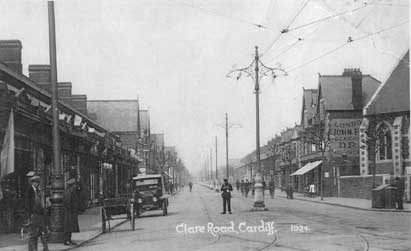
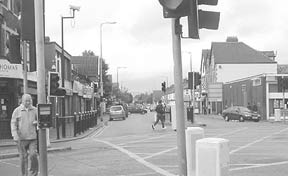
Clare Road, from Penarth Road and then (below),
Penarth Road near the Clare Road junction. The old Penarth Road methodist church
on the corner has been replaced by a supermarket after first closing and then
being badly damaged by fire in the 1970s.
More photos of Grangetown then and now
| JULY 25-26 1886: A bridge too far
Two nights of disturbances in Grangetown made the
national news, as workers held a mass demonstration against tolls being introduced on the road linking the suburb with their workplaces in the docks.
It centered on a swing bridge at the Old Sea Lock over the Taff in Penarth
Road, linking Grangetown with the docks. It was a private road leased
by the Taff Vale Railway Co and which had cost £60,000 to build
in 1861.
Suddenly the company wanted to enforce its rights. Working men were
to be charged a penny for walking over the bridge, and the toll rose for
those with animals or in carriages. The Western Mail reported that
almost every resident of Lower Grangetown was against the toll, which
would lead to hardship and inconvenience in many cases. By the first day,
around 100 householders had already decided to give notice to move, because
they could no longer afford to live in the area - and the paper mooted
that if this continued, the area would soon become "a deserted village".
By 5.15pm on the toll's first day, feelings were running high and crowds
of men, women and children headed towards the toll-gate, as workmen started
heading for home from the Docks. When workers returned
again that evening, a crowd of about 1,000 gathered again and a group
of ship's carpenters took the gate off its hinges and threw it into the
river.The Times reported that 1,000
men took part in the protests each day against the railway company. There
had been "upmost good humour" for the most part, as 200 police stood by,
but then there was direct action. "They rushed at the newly-erected toll
gate and tore it from its hinges, throwing the structure in the river."
The first gate was replaced the following
day, as well as a sentry box for the toll-keeper. The toll house
was also damaged. The paper later publishes court reports
of three men who were arrested for causing the damage, costing £5
- Cornelius Dacey, William Smith and William Webb, all under 23. Police
were also after another man called William Drew, who was heard to shout
"Go it boys, that's right, pull it off!" The court was told of "200
armed navvies with iron bars up their sleeves." The three were found
guilty and the judge expressed sorrrow at having to sentence them to a
month's hard labour.
There were attempts to resolve the issue, before and after the direct
action. The matter was raised at a public meeting on July 20th at Clive
Hall, chaired by Mr Alderman Jones, in which it was agreed to send a deputation
to the company. But the bureaucracy and resistance by the company prevailed.
By the time the toll was brought in the following week, some of the 600
men who daily used the bridge decided to take the long route via Penarth
Road and Bute Street or catch a tram, rather than pay the toll. They even
tried to start a ferry service, costing a halfpenny. After the mini-riot,
negotiations continued between borough and company, which eventually led
to a commuting of the toll for foot passengers, as the company were unwilling
to sell the bridge and road to the corporation. Problems continued and
the head at St Patrick's School noted in August a fall in pupil numbers
- "many families are leaving the neighbourhood owing to the enforcement
of the toll in Lower Grange." The same in November, with the situation
having "made a great difference to the attendance of the school, many
families having removed in consequence."
But the men won an eventual victory. It led to the corporation building
the Clarence Road and James Street swing bridges, and the railway company's
bridge was dismantled within 10 years.
|
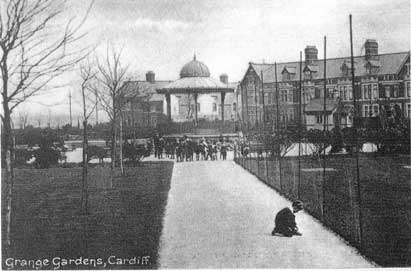
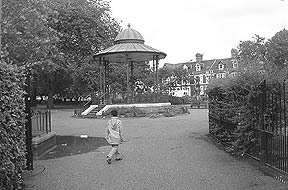
1895: Grange Gardens
Grange Gardens was a gift to Cardiff in
1894 by Lords Bute and Windsor, who owned the land on which it stands. Just
over 9,000 square yards belonged to Bute and 5,764 square yards came from the
Windsor estate. The bandstand cost £2,374 and was constructed at the same
time as one in Victoria Park. However, it was complicated by the fact the wrong
foundations were laid for the bandstand in Grangetown. "Grangetown Gardens"
were opened on June 19th 1895 by councillor Joseph Ramsdale, the chairman of
the parks committee. "A very large number of the inhabitants of Grangetown"
gathered for the ceremony and the mayor proposed a toast to Lord Bute and Lord
Windsor. Mr D A Burn's Roath brass band entertained with a selection of tunes.
There was also a celebratory dinner later.
Above is an Edwardian photo of Grange Gardens with the original bandstand.
See the little boy tying his shoelaces before joining his friends in the background.
The war memorial was added in 1921 at a cost of £1,000. Was this lad in
the photo one of the ones who returned safely? Interestingly, a plaque was added
in 2000 in memory of Private W Langstone, whose body was only found nine years
after the end of the war and who was missing from the memorial. Surviving members
of his family attended the ceremony, along with representatives of many service
organisations. A further plaque to later Grangetown war dead has been added.
You can read more about Grange Gardens' history here and there is a lot more about the Grangetown War Memorial and the men on it on our
World War One project website
| 1891-1901: Saltmead grows up,
a little forgotten

This block of cottages in Court Road,
along with a grocers and butchers's shop on either corner, were built
in 1891-92 by builder David Davies.
The homes and shops opposite were built by WT Ellery four years before.
You have to look hard these days to
find evidence that Saltmead as a place, ever existed. Which is a shame,
as a case has been made for an area which developed semi-independently from
Grangetown. The salt marsh "Saltmede" is mentioned in the Valor Ecclesiasticus
(1535). Saltmead Presbyterian Chapel was built in 1901, on the corner of Hereford
Street and Avoca Place - there is now a modern replacement building. We
still have a Saltmead surgery in Clare Road. But the name seems to have
dropped out of use and fashion. Local historian Colin Weston made the argument
in his short history of Saltmead, which appeared in Grange News in
1981. For him, Saltmead was a "forgotten district of Cardiff". It became
known as Upper Grangetown sometime in the 1930s, as Saltmead was swallowed
up.
"Unlike Tiger Bay, Saltmead was a real place, yet in many ways it
was very similar to the Bay. Many different races settled in Saltmead,
men gambled on street corners, police walked around the area in pairs.
Here and there some households had donkeys in their back kitchens and
pigs in the passage. The roads were very empty in the early days, except
for the horse and carts of the milkman, coalman and the local builders."
Saltmead is quite evocatively described in a memories column from an
old Cardiff newspaper in 1940, looking back to when the houses were built
on former farmland behind Clare Road for £120 each - a bigger yield from
the rents of the growing migrant workforce than brought off farming the
land. Rents were charged of six shillings a week - nearly a third of the
working man's not always regular income. It admits that they could suffer
wage loss due to rain or frost and looked elsewhere.
"Old Salt" writes: "In days gone by, owing to the influx of new workers,
promised employment in the town and unable to find it, the practice arose
of these workers hawking coal with donkey carts. The cart was parked in
the roadway at night but the donkey was led through the passage and stabled
for the night in the kitchen."
It is not hard to imagine those builders' carts, when you look at how
Saltmead quickly developed from the end of the 1880s. It was not without
its problems - builders' strikes, short-term housing slump and problems
with drainage from building on marshy land.
In July 1890, Stephenson and Alexander
(agents still in existence today) held an auction at the Royal
Hotel. It included 70 lots of building land for development. These included
part of Allerton Street and what is now called Sussex Street (then Staughton
Street), and a large tract of land between Somerset Street, Compton Street
and Hereford Street, off Court Road, which was offered as either land
for industrial development or "small houses...which would easily secure
tenancy." The roads and sewers had already been put in place; all was
needed was the houses. There were also 35 houses offering rents totalling
£189 5s 7d. One house in Dorset Street, commanded a rent of £1 6s and
8d, while a bakehouse on the corner of Staughton Street and Court Road
was worth £6, 8s. However, an earlier sale in 1887 had attracted "meagre"
interest according to the Western Mail, and proceedings were called
to a halt after low prices for some building land in Court Road.
Court Road, as an example, with its late Victorian terraced homes is
a fascinating snapshot of this piecemeal development, as well as how people
moved to Cardiff.

The old Saltmead Presbyterian Chapel, a photo taken in about 1980 - the old
building is now gone, as you can see from the change photo, with a smaller
church next to a flats development.
The road started to be built in the 1880s. At first glance, it's just
another terraced street but you quickly notice the different styles to
the houses along it, reflecting the numbers of builders involved and the
time it took to complete. You can still see the date 1887 over the doorway
of Number 8 and this end of the road was mostly developed from this time,
but it was slow progress. Building continued off and on over the next
eight years. Houses had sculleries and kitchens, and the plans show outside
toilets and coalhouses. Some of the corner shops had stables for up to
four horses and coach-houses. Typically of the area, a number of different
builders were involved: Llewellyn Thomas built more than a dozen homes
and shops in Court Road between 1887-88, but others like W T Ellery, David
Davies, Alfred Dando and Llewellyn Preece built smaller numbers. The Court
Road School also stood where the newer homes off Rutland Street and Courtmead
Gardens stand today, opening in 1893.
In 1893, there was a bit of a "stink" over refuse being buried in Grangetown's
open spaces, which were the new building sites. There was a difference
of opinion between Cardiff's public health official and surveyor. The
former believed it was "very undesirable" to make use of "offensive refuse"
from elsewhere in the town, but the latter argued "a man might as well
object to the use of manure in his garden." He believed that a similar
burial of "carefully selected" waste at Ely Common had not been a health
hazard. There was nothing wrong with vegetable matter, offal and filth
finding its way under the new houses. But it certainly aroused enough
controversy to need a public meeting. The "Man About Town" column in the
Echo poured scorn on the "pathetic touch" of "indignation of the
good people of Grangetown having their new homes built on refuse."
Interestingly, by the early 1890s, local councillor SA Brain had been
complaining about the "swamp" in Saltmead, so much so, that
he believed he was regarded as a nuisance at the authority. These problems
with the new housing by 1898 became known as"Saltmead swamp" scandal.
Cardiff's medical officer found drainage and health problems due to some
homes being built on clay, with stagnant water under the floors. Dry rot
had affected the woodwork, with damp in the walls. The Western Mail
criticised the situation, questioning the planning process and builders,
saying the "poor were being choked out of existence in the Saltmead swamp."
"The fool who built his house upon the sand was a wise man by comparison
with the builders of certain streets in Saltmead." Homes were slowly
rotting away, "built on filth" - on pools of stagnant water and ditches.
A cattle market would be cleaner, "and a prison brighter, healthier
and purer", said the Mail. The reporter found 30 empty houses,
boarded up in Stoughton Street, some tenants moving upstairs to live.
There were another 14 empty houses in Hereford Street, 16 in Saltmead
and Court roads and six in Allerton Street. One town engineer had tried
to blame the rough neighbourhood and tenants "knocking about" their homes.
But the reporter could see why some would have looked for distractions
in the pub and elsewhere due to the "noxiousness" of the place they call
'home.'
The borough inspectors visited houses in Compton Street, Somerset Street
and Saltmead Road. As well as finding a list of building and drainage
defects, they saw tenants with symptoms of rheumatism. But they also found
that not all homes were affected and there was evidence of maltreatment
of houses by "careless and indifferent" tenants. Councillors
visiting the area found workmen on roofs and in backyards in Court Road
and Compton Street, where bricks were simply crumbling away in some houses.
One resident complained of rats and how his wife could not keep their
children's feet dry indoors in wet weather:
"At one house in Compton Street there was a hole in the passage
near the door, and the occupier informed his visitors that every night
the rats from the space beneath crawled up and held high revel in the
rooms. The water came into the house from the street on account of the
defective shutes, and it was impossible for his wife to keep the children's
feet dry indoors in wet weather. "
Feet sank in the backyard
at another home in the street "several inches into the sodden, ill-smelling
soil." A floorboard was taken up underneath a house in Court Road
and 3ft beneath was a mass of foul-smelling slush. The issue was enough
to create concerns for the housing planned for the roads laid out between
the Taff and Clare Road - now Taff Mead, which had been used to bury refuse
and where children used to swim and skate on ponds.
The censuses of 1891 and 1901 are wonderful tools for giving a snapshot
of what Grangetown was like more than a century ago. The area today is
profoundly multi-cultural, not just with Asian and African communities,
but with eastern European migrants and a population which changes by around
a fifth every five years. At the end of the 19th century, the growth of
Cardiff as a city was driven not just by the general population rise,
but by the migrant workers who moved from rural parts of Wales and England,
other towns and cities and Ireland. Saltmead, provided housing for a time
when the town's population grew rapidly. The 1891 census shows Court Road
partly developed with around 50 homes - many of those living there are
workers who had moved from Somerset, Gloucester, Bristol and other rural
areas. The Clare Road-side of the terrace seems to include a number of
railway workers, but there are trades ranging from blacksmith, butcher,
groom to tailor and sawyer. A few homes also took in lodgers and boarders.
William Causey, a Devon-born carpenter lived with his wife and four children,
all under four - but also took in two boarders from his home town, who
were plumbers!

By 1901, the pattern of workers settling in the boom town continues,
although by now the whole road has been constructed. Into one of the last
block of homes to be built were Devon-born James Youlden, 48, who was
a boildermaker's helper (later ship rivetter). He lived with his wife
Elizabeth, 42, born in Gloucestershire, and their three sons, aged 13
to 16, all born in Cardiff. The family had moved from nearby Devon Street,
where the two youngest were born. The eldest Robert worked as a waiter
in the railway rooms. Another Sam later became an engine driver, according
to local records, then an electrician/labourer, while son Charles became
a teacher and the family moved to Severn Road in Canton. Next door one
side lived Charles Davies, 51, a stonemason, and wife Mary, 56, both originally
from Ross-on-Wye. Their four children included the eldest, Mary, 21, a
"domestic" and son John a butcher's assistant. The other side of the Youldens
was tailor Richard Giles and his wife Emily, both 38, orginally from Monmouth
and their two children. Other neighbours of the Davies family were John
Reed, 40, who was a more recent migrants. He was born in Hong Kong, while
his wife Annie, 40, was a Londoner. They had brought their eldest daughter
from London, but youngest Olive, six, was born in Cardiff. Living next-door
to them is water clerk Godwin Palmer, 33, wife Cicily, 29 and three young
children. They were another couple from Monmouth.
Court Road has only one shop today, but at the end of the 19th century
- before cars - it was a busy mix of shops and terraced homes. In 1899,
according to the Western Mail's Cardiff directory of the time we
find five grocers, three butchers, two green grocers, a newsagent, other
unnamed shops. Edward Ribton's fried fish shop is now a mid-terrace house
a block away from the surviving corner shop.
By 1890, the first few homes had been built on Cornwall Street, Court
Road, Allerton Street and Hereford Street, but other streets would follow
within a few years. Given the origins of so many of the population, it's
not a surprise then that street names like Cornwall, Hereford, Somerset,
Monmouth and Devon appeared in this part of upper Grangetown. Other names
were eventually changed - Staughton Street became Jubilee Street and Sussex
Street, Saltmead Road became Stafford Road.
Some of the street names in other parts of Grangetown owe their connections
with the Plymouth estate. As well as St Fagans and Rhydlafar streets,
there is also Penhevad, Pentrebane, while Stockland Street is named after
a farm north of St Fagans upon where Royalist and Cromwellian troops fought
a little-mentioned bloody battle in the Civil War.
Spaniard's adventures in Saltmead - from Cardiff Times, 1906
"The salubrious neighbourhood of Saltmead still appears to contain pitfalls for unwary seamen. Spanish fireman Francisco Garcia arrived in Cardiff and met Gertrude Brown, 29, and Emily Duffy, 27, whilst walking the streets at four o' clock in the morning. He was invited to a house in Stoughton Street where he saw a third female, Anne McDonald, 45. Duffy took charge of him and he went to sleep but on waking an hour later discovered his purse, containing £2 6s was missing and Duffy was in the act of pulling at his watch chain."
|
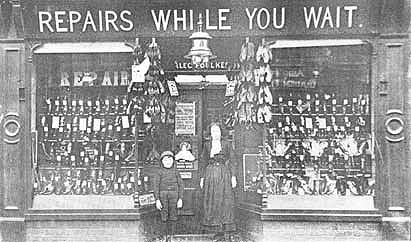
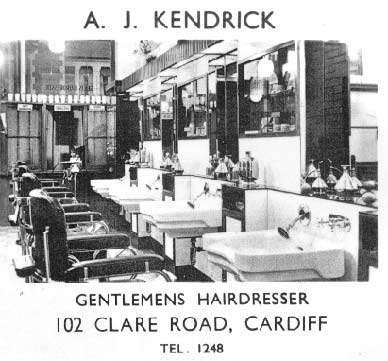
Foulkes' shoe shop in Holmesdale Street in
1914. Nowadays you can only get sole - it's the Holmesdale Street Fish Bar!
Before that in the 1880s, sign-writer Edwin Johns lived there. Pictured right
is an advert for the barber's in Clare Road - now a private house.
| APRIL-MAY 1893:
"That business, pure and simple, appeared to be consuming as much beer
as they possibly could"
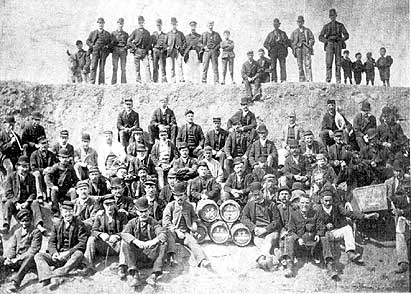
The Hotel de Marl, as photographed by GH Lawrence of Cardiff.
It was seen as remarkable at the
time, and it looks pretty odd even today - but hundreds of Grangetown men
got around the Sunday drinking laws in 1893 by founding open-air "gentlemen's
clubs"
The practice had been going on for several months when it became the
subject of a court case in April 1893 - and the landmark ruling gave rise
to a brief but infamous flurry of more open-air drinking in Grangetown.
The first recorded example was in a field in what is now known as Sevenoaks
Park. It lay between Penarth Road and modern day Sloper Road, known as
Tanyard Road (after the Tannery) back then.
Police had already been monitoring the Sunday morning exploits of a group
of local working men, who would dig a hole in the ground to be used to
gather a kitty of 4.5 shillings. And then they would bring a 4.5 gallon
cask onto the field. Eventually it to led to a court case, where James
Donovan was accused of breaking the Sunday licensing laws on 2nd April
1893. Giving evidence, two policemen, from the vantage point of the signal
box on the railway embankment above, said they had noticed a group of
up to 16 men gathering by 10am. This group grew to 38 by 11.30am, according
to one of the officers. A cask of beer, bought from Mr Gillard's shop
(Holmesdale Street), was placed by a John Parle - a mason's labourer from
Thomas Street - on a fence and beer drawn into a tin can and glass. The
officers claimed a man went around the group, seemingly to gather money
- illegal according to the laws.
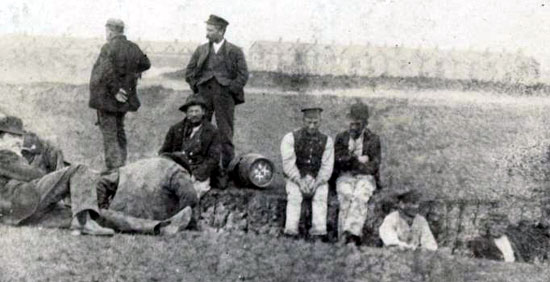
Now at this time, behind closed doors, gentlemen's private clubs could
serve - if not sell - alcohol on a Sunday. This grey area was where
the legal argument was heard in court, with the stipendiary magistrate
taking two days to reach his decision. Could a field be defined as a "place"
to consume alcohol under the Act? While there was also doubt whether men
chipping in to buy ale was the same as someone selling alcohol.
The stipendiary magistrate ruled that the gathering of humble working
men constituted a club. It was "a rude and elementary type but still a
club", as much as "the best and most exclusive in the country."
He ruled in Donovan's favour.
With this legal obtacle removed, the practice soon drew bigger crowds,
spread elsewhere in the area and gained national notoriety. Pits were
dug 8ft deep in the clay ground of The Marl across Grangetown to form
the walls, carpet was laid out and up to 400 men sat around, as beer was
poured freely from casks from 7am until 9pm at night. No alcohol could
be officially sold, but members made "donations," with sixpences
and pennies collected in old copies of the South Wales Echo. By
all accounts, this arrangement was fairly observed and the men were impeccably
behaved. As one of the organisers said, likening the activity to the champagne
drunk in the private members County Club in Westgate Street: "Them pays
as likes and we all drink square."
The Echo's correspondent joined the group for refreshment at the
"Hotel de Marl" on May 7. The reporter found 70 men, seated
in a cresent shape in two rows, with the chairman of the gathering, known
as "Jeremy." The report says: "He occupied an elevated position
on a 4.5 gallon cask of double X beer (empty)...a man called 'Bill', humourous,
red-whiskered and as it transpired, strictly law-abiding character, acted
as drawer". He filled the men's decanters while they, from time to time,
put money into a "tattered" copy of Saturday's Echo. Fresh supplies
were brought from a licenced drink wholesalers in nearby Clive Street.
It was estimated a 4.5 gallon cask was consumed every 20 minutes. The
reporter, on the edge of the pit, was "good humourly" invited down and
offered a glass of beer. "One glass of that beer was enough for anyone
who really valued a good draught of the national breweries."
"The civility of the crowd was no less remarkable than their determination
to obey, while this consented to be the law and to avoid creating a nuisance
and a scandal," said the correspondent. He said there were "no loafers
or corner boys," juveniles were ordered away and the majority of the crowd
were "working class masons, fitters, engineers, a few dockers and sailors."
He added: "If questioned, I should positively deny that the men I saw
were idlers, or blackguards or scoundrels of sorts."
The reporter also saw some "well-dressed people," possibly on their way
back from church or chapel. Another account reported a group from a theatrical
company, who were playing in town.
"They were working men, pure and simple, with a flavour of strong language
and stronger tobacco but undeniably wage earners," said the Echo
man.
A separate account in the London Pall Mall Budget found people
turning up in cabs "laden with kilderkins of beer" from as early
as 7am. Fourteen kilderkins (about seven barrels) had been drunk
in 10 minutes. Quoting The Morning paper in Cardiff, it was estimated
there were 360 "club members" and another 1,500 spectators. "It appears
almost incredible that the proceedings should have been so harmoniously
conducted as was the case," reports the paper. It found "perfect order"
as the various clubs were "engrossed" in emptying 4.5 gallon casks
and to remind one another there was not sufficient money on the carpet
to pay for the next, "to pay much attention to anything but the business
in hand."
It added: "That business, pure and simple, appeared to be the consuming
as much beer as they possibly could."
Up to 5pm, more than 80 4.5 gallon casks were emptied, but after retiring
for tea, a "roaring trade" was expected in the evening.
After the attention given to the field club, the "disgraceful exhibitions"
were attacked by Canon Thompson in a lecture to the YMCA. He appealed
for an end to the "club", for the influence it might have on
children. By June, Lord Windsor had banned drinking on his property and
threatened arrests for trespass for anyone found drinking on the Marl.
The drinking club was also taken to meeting in other locations near Canton
Common, as well as meeting at the Marl just after midnight to avoid police.
Another club was reported in a field off Clare Road. The Western Mail
remarked that while Sunday was usually the quietest day of the week, in
Grangetown "it was just the reverse." The scenes taking place were "disgraceful
and demoralising."
* There had been an issue for a few years regarding the 1881 Sunday
drinking laws in Cardiff. There were claims of hundreds of "shebeens"
- illegal drinking dens - in the town. Newspapers speculated that the
large Irish community was one factor for their popularity. In 1889, a
Royal Commission heard evidence that there were 450 shebeens in the town
and that police raids couldn't contain the trade. The Western Mail
sent a team of ordinary people under cover to investigate their extent.
In Grangetown, they found 40 shebeens with 173 people present - Cardiff-wide
it amounted to 3,196 in 457 shebeens. There were around 58 people in one
alone in Andrew Terrace, five shebeens in in Hewell Street and Havelock
Street, four in Lucknow Street, two each in Saltmead off Cornwall Street,
Cornwall Road, Court Road, Hereford Street, Holmesdale Street and Sevenoaks
Street, other shebeens in Andrew Terrace, Bishop Street, Courtenay Street,
Earl Street, Newport Street, North Street, Oakley Street, Plymouth Street
and Redlaver Street. Dr Gibbins, the curate at St Paul's Church in Grangetown
said the Sunday closing act had had an "evil effect" on the
area, with drinking been driven underground in clubs and where illicit
drinking in homes had become "widespread." The inspectors also
found illegal drinking in shops, including two fried fish shops and a
barbers. Convictions were running at one a day in 1891-92. In February
1892, police raids included houses in Earl Street and Cornwall Street,
with 4.5 gallon casks of beer confiscated. In October, police found 17
people drinking at William Jones' house in Dorset Street - 11 of them
women. Charles Morgan in Saltmead Road said he had to provide for his
family, as he had been in hospital.
A court report from 1898 is typical: George Bennet, alias Harry West,
was summonsed for selling beer without a licence at a house in Compton Street, after a police constable had watched on a Sunday morning in April:
"He saw six women and four men enter, and five men and two women leave.
A man, named Thomas Hackett, carried into the house something like a 44-gallon
concealed under a sack. In the passage he met a woman, named Kate Leeley,
with two pint bottles underneath her cape, aud in the back kitchen he
surprised two women and a man. who were refreshing themselves with beer."
|
|
1899-1912: Distress and disease
Of all districts in Cardiff, Grangetown
had the highest number of people classed as paupers, who were granted poor
relief by the Cardiff Union. There were two types - those, mostly men, who
were in the workhouse (the old St David's hospital site in Cowbridge Road)
and the others, mostly women, who lived in the community as "outdoor
paupers" but were granted a few shillings a week to live on, or payment
in kind in the form of food, boots or medical expenses. Their experiences,
as listed in the Cardiff poor relief books, show a myriad number of maladies
and misfortune. There is simple old age, widowhood and infirmity, people
who have lost limbs or are blind, others succumb to phthisis (better known
as tuberculosis), bronchitis or are senile. Others have been "deserted"
or their husbands are "at sea" or "in prison". Others
are simply classed as destitute.
Few streets in Grangetown escape unscathed. At the end of the century,
Grangetown has a list of 195 families receiving "outdoor" relief. Across
the town there were a total of 140,000 days relief paid out, with nearly
24,000 in Grangetown. This list of families steadily rises past the 300
mark by 1906 to a peak of 330 in 1911 - a total of 838 adults and children
out of 13,291 in the town.
In 1906, for example, across Cardiff, there were 11,798 people receiving
"outdoor" relief, with 709 of them (at its highest 311 families) in Grangetown,
broken down as 91 men, 273 women and 345 children. Admittedly, Adamsdown
and Splott at this time were counted as separate districts, which if combined
would have seen 964 people classed as paupers in the community. In addition,
1,342 men, 729 women and 683 children in Cardiff were receiving workhouse
relief, with another 4,425 people classed as vagrants.
* If you want to view the poor books for yourself, the volumes are kept
in the local studies section of Cardiff Central Library.
Infant mortality was an issue of real concern at the end of the 19th,
start of the 20th century. There had been improvements in sanitary conditions,
the start of vaccination but the numbers of children, dying of malnourishment
for instance, had actually gone up in urban areas at the turn of the century.
To compare, today in Wales the average infant mortality is five deaths
per 1,000 births - in 1902 in major towns it was 146 deaths per 1,000.
That was around 150,000 babies dying a year. It was worse in the large
northern towns and cities, especially where women went out to work - they
could be back in factories and mills a month after giving birth. In Cardiff,
health officials prided themselves that the death rate was the lowest
of all towns of a similar size, and half that of places like Liverpool
and Manchester. If you look at Grangetown, it did show up as a pocket
for deaths in diseases like diphtheria, compared to other parts of the
town. Diarrhoea was also a killer - especially in hot summer months -
in the days before fridges - cases rose 70% in the first few years of
the new century. In 1900, in one three month period in Cardiff there were 611 deaths - of these, 212 were babies under one and 276 were children aged between 18 months and five years - only 81 were deaths of people over 65. (Broken down there were 62 diarrhoea deaths and 21 from diphtheria; other causes were whooping cough, scarlet fever and typhoid) Grangetown's death rate was 15.9 per 1,000 compared to a Cardiff average of 12.5.
There were studies, inevitably, into the causes. Some dismissed arguments
over poverty, claiming bread and meat were cheaper and wages were higher.
Some of the health arguments are familiar to us today - issues like breast
feeding, while there was criticism of diet and the basic milk substitute
products of the day. The conclusions, which did lead to improvements within
a few years, were that women needed more health and nutritional care while
they were pregnant - and again after they had given birth. In Cardiff,
they had a public meeting in 1905 to address the issue of underfed children
in the town's schools - so there were issues of nutrition for some children
who were older.
|
| JANUARY 12 1895:
Ice tragedy for local rugby star
This particular sad story illustrates
something of what it was like in what is now the Taff Mead area, before
Merches Gardens, Hafod and Mardy Streets were built at the end of the century.
As well as being an area for dumping some of the town's refuse, there were
also brick ponds between the River Taff and Clare Road. These ponds seemed
quite large, and were popular with townspeople for recreation. They were
on privately owned land, leased by a Mrs Jones of Francis Street (now Franklen
Street) who would charge a 3d toll for entry.
 In winter, when they froze over,
the ponds were popular with skaters. On this particular Saturday, tragedy
struck involving a well-known local rugby player. "Dick" Davies (left)
was 26 and was a "dashing forward" for Cardiff football club. On this
particular weekend, he couldn't join his twin brother William and the
rest of the squad because of an ear injury. They had travelled all the
way north for a match at South Shields. Dick instead, visiting his mother
and sister in Allerton Street, joined up to 300 other people skating.
He was one of half a dozen men who went through thin ice, as it grew dark,
10ft from the bank and left struggling in 12ft deep water. Poles from
a building shelter were thrown across the pond for the men to reach. Spectators
used planks and linked hands to try to reach them. In winter, when they froze over,
the ponds were popular with skaters. On this particular Saturday, tragedy
struck involving a well-known local rugby player. "Dick" Davies (left)
was 26 and was a "dashing forward" for Cardiff football club. On this
particular weekend, he couldn't join his twin brother William and the
rest of the squad because of an ear injury. They had travelled all the
way north for a match at South Shields. Dick instead, visiting his mother
and sister in Allerton Street, joined up to 300 other people skating.
He was one of half a dozen men who went through thin ice, as it grew dark,
10ft from the bank and left struggling in 12ft deep water. Poles from
a building shelter were thrown across the pond for the men to reach. Spectators
used planks and linked hands to try to reach them.
The Western Mail reports how Dick "struggled manfully" and was
seen trying to remove his coat - which onlookers say may have entangled
him. But he was too far away and disappeared before assistance could reach
him. Peter Lynch (101 Clare Road) recovered his body half an hour later
and it was taken to the mortuary to be identified by his mother and sister.
Two other lives were saved by a Norwegian sailor, George Jacobsen. E J
Humphreys, from Adamsdown was rescued after grabbing hold of a plank.
"They laid me on the bank and started pumping me, they thought I was passed
recovery," recalled Mr Humphreys, a non-swimmer. He was taken to the Neville
Hotel, where he was given clothing and refreshments by the landlord Mr
Gillard.
Dick was employed by the Barry Railway Company as a plumber and he lived
with his brother-in-law Frank, an engine driver, in Barry. Dick had briefly
left Cardiff to work in Huddersfield during a builders' strike and was
selected for the town's team. "A genial young fellow, liked by everyone"
he was due to be married in the summer to Prudence Goodhall. His body
was taken to his mother's house at 19 Allerton Street. She had been making
his tea when he drowned and cried repeatedly "if only he had gone to Shields"
when she heard the news. The sad news was telegraphed to Tyneside and
Charlie Arthur, Cardiff rugby club's secretary, who relayed the news to
Dick's brother and the team. A F Hill, captain of Cardiff, led the funeral
procession on the Wednesday from Allerton Street, swelled by members of
other local rugby and cycling clubs. The pall-bearers were four members
of the Cardiff team. A special train had carried 250 of his work colleagues
from Barry. He was buried in his club colours.
* An earlier newspaper report from
1893, comparing skating ponds across Cardiff, called another 3ft deep
pond off Ferry Road at the Grangetown Brick Works, "the finest piece of
ice in the town." A small charge covered the hire of skates and you could
have a coffee from a cottage next to the pond. There was
also a Dumballs pond, off Penarth Road, "frequented by people whose
company was anything but congenial."
|


Here's a photo dated from about the turn of
the century, in Lower Grangetown. It shows Margaret Saddler standing outside her
son Fred's shaving saloon - near the junction of Worcester Street and Oakley Street.
She would have been in her early 50s at the time this was taken, her son Fred
around 20. Father Edwin was a sailor. These are two of the "disappearing"
terraces, which were replaced by modern housing and an OAP complex. The shop was
still a hairdresser's in the late 1920s.

Some of the earliest-built streets in Grangetown were demolished in slum clearances
of the mid to late 1960s. The first batch of streets to be looked at were Thomas
Street, Madras Street, Lucknow Street and some homes in Franklen
Street and North Clive Street in 1966. Many homes there had been
deemed unfit for habitation. Cardiff Council started compulsory purchasing the
streets. The values of the homes - which dated from the early 1870s - ranged
from as little as £85 to £1,400 depending on length of lease remaining
and condition. As the policy progressed, there were complaints about the state
of empty houses in 1967, with most people rehoused but a few waiting for new
flats near Lawrenny Avenue in Leckwith to be completed. The London Style Inn,
Penarth Dock pub and an old bakery were also demolished. The land was to be
used temporarily for a car and lorry park, and children's playground, before
the eventual building of the new St Patrick's School in Lucknow Street.
A second phase of slum clearance was also drawn up following health inspections
which identified 204 unfit homes in Knole Street, Sevenoaks Street, Oakley
Street and Hewell Street (above in 1937) - where its 70 homes
also made way for a new school and modern housing in the 1970s, after standing
for a century. The report found 226 families needed rehousing, with three pubs,
a surgery, dairy, betting shops, print works and 17 shops also affected. In
Grangetown Local History Society's Old Grangetown Memories Book One,
Alice Butler recalls: "We bought a house in Knole Street for only £120 because
there was not much lease on it, and when they knocked it down I had £1,000 for
it and moved here (Thomas Street)."
Reports to council found residents "anxious" to be rehoused back
in Grangetown as soon as possible after the slum clearance. In 1968, an action
area was drawn up for the Madras Street and Thomas Street area, which set aside
flats for 160 people - especially the elderly, with 45 homes in Thomas Street
built at a cost of £152,000 by Bond Brothers. The development also included
the new Catholic primary school, St Patrick's Hall, roads being closed off and
new paths linking Durham Street and Dorset Street.
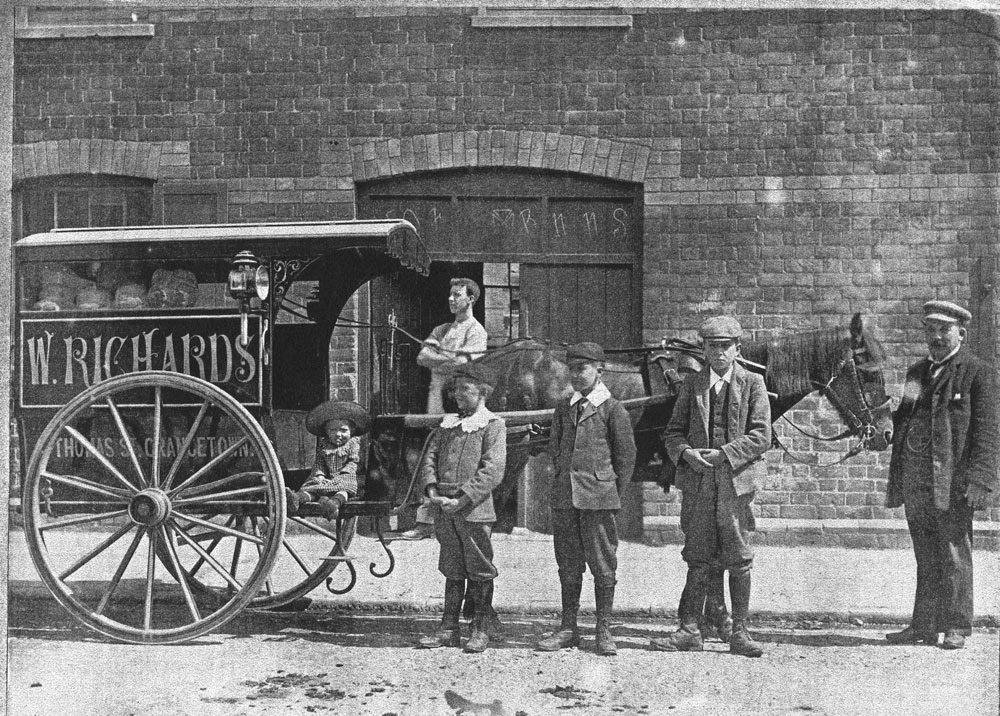
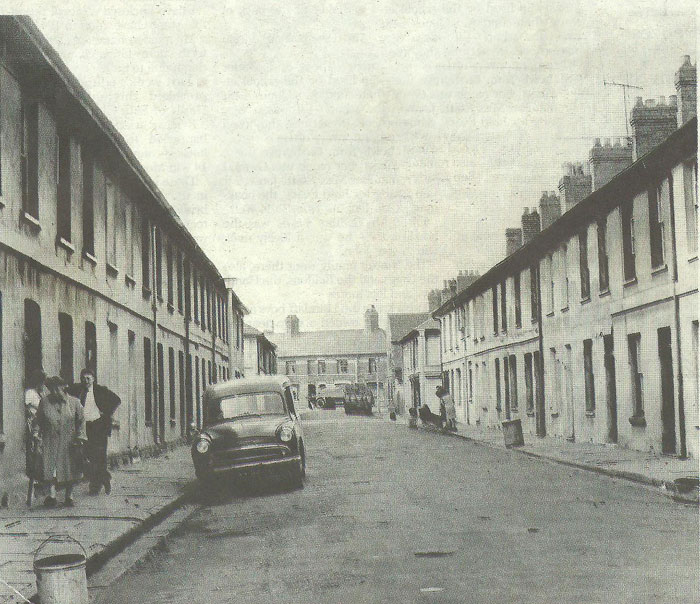
This is Richards' bakery in Thomas Street.
The original homes in the area were demolished and replaced with new houses
and maisonettes in the 1970s. Thomas Street looks very different these days.
| FEBRUARY 1904: Unsolved and mysterious murder in Saltmead
She was found dead in bed, with a rope
around her neck and a huge puzzle about not only why she died and who killed
her, but what her real story was. The body of Harriett Stacey, 50, was found
on February 14th 1904, around a week after she was strangled, in the front
bedroom of her house at 41 Saltmead Road (since renamed Stafford Road and
near the junction with Cornwall Street). She was strongly suspected at the
time to be working as a prostitute, but there also existed at the time a
notorious diary, which she kept and was deemed too scandalous to be detailed
at her inquest or divulged in the newspapers, which hinted at clues to her
sexual appetites and deviances.
She was a mother-of-six, originally from Market Drayton, Shropshire,
who via Brecon had come to south Wales from Hereford and a marriage to
engine driver husband John Stacey. After an affair with the couple's lodger,
a sewing machine salesman, she came to live in Cardiff a few years before.
At the time of her death, she was living with a man called Robert England,
a Dutch marine engineer who had left on a voyage in January and was still
at sea when she was killed. Neighbours thought he was her husband and
she was also known as "Kate Stacey" or "Kate England".
According to the South Wales Daily News reports of her "foul murder,"
she was last seen alive over the back garden wall by her neighbours at
No 39, Thomas Williams and his wife on February 7th, a week before. But
the initial suspect, the man who discovered her body, was a William Henry
Warren, a widower from East Moors, who visited her regularly. Neighbours
thought he was her brother but, as he told the inquest, "draw your own
conclusions" when he refused to deny he was a paying customer of Harriett's.
The newspaper said she had "many and frequent visits"..."in most part
from the seafaring class," and "at all hours of the night." In a darkly
comic twist, she kept her door key on a piece of string from the letter
box for convenience because her poor hearing meant callers frequently
had to bang hard on the door to be heard. Warren, who had called with
a loaf of bread, was worried when he failed to rouse her, and suspicions
grew when she was not seen, the blinds remained drawn and washing undone.
Warren found he could not enter the house in the usual way and filed down
his own key to gain entrance before taking a matchlight and making the
grim discovery in her bedroom. The police and surgeon found her in a nightdress,
a rope around her neck, loosely tied to the bottom of the bedstead. She
had been strangled and the surgeon concluded it had been expertly done
and she would have died instantly.
Her estranged husband John was at the inquest, when he questioned Warren about his relationship to her. Mr Stacey claimed not to have seen his wife for two years. Although at least one of her grown up daughters lived in Cardiff too, they were apparently discouraged from visits by their mother.
Harriett Stacey was believed to have been planning to leave Cardiff
and had bought a trunk from her neighbour, had £40 in her account - which
confirmed a local view that she was "never in want of a quid." She was
known to be a regular visitor to LondonThere had certainly been a search
of her possessions by whoever killed her, her purses were empty although
nothing was obviously missing and the next door neighbour belatedly recalled
the sound of what might have been chopping wood from a fire coming from
inside the house late one night in the days before she was found.
Her diary is referred to by the newspaper, as being a journal in which
she kept record of money coming in and out but also "all sorts of peculiar
entries....of a remarkable character and are of such a character they
cannot be disclosed." There is a hint in the report of the inquest that
after a "crisis incidental to womanhood" may have led to a "moral looseness"
and the diary entries reflected a "depravity of the mind of the worst
type."
It certainly kept the gossips busy. The Evening Express reported
that shortly after 5 o'clock on a morning early in the week Mrs Stacey
was found, a man rushed into Mrs Hutchinson's shop on the corner of Court
Road and Clare Road "without a cap and asked if she had one to lend him,
saying it looked bad to have to go to Cathays without a cap. Mra Hutcbinaon
had not one to lend, and the man made a hurried exit from the shop, which
he had only been in some three or four seconds. The man looked excited,
and was evidently in a great hurry, said Mra Hutchinson. He was about
middle height, clean shaven on the chin.." and wore a moustache. He was
fairly well dressed, and had no overcoat on. I shouldn't k'now him again."
The following September, her lodger Mr England indentified the rope
as her clothes line and told police in a statement she was the "type"
to commit suicide, having endured much acute pains from an iuternal ailment,
as as from neuralgia.
* Mark Isaacs details the case in his excellent Foul Deeds & Suspicious
Deaths In Cardiff (£12.99, Pen & Sword) and speculates that possibly
Harriett was involved in erotic practices in which her death could even
have been accidental, with the "killer" only trying to get rid of traces
of himself.
|
| 1873-1899:
From Somerset and back again - a migrant's' tale
ANDY DENHAM brings the family history
of his ancestor Fred Denham, one of the many migrants from Somerset and
the west country who made their home in Cardiff, and Grangetown in particular.
He was a farmer's son, from Wellington near Taunton, who following a family
row decided to leave and find work in the growing town at the end of the
1860s. He was involved in the new Clive Street baptist chapel in Grangetown
and spent more than 25 years in the area before returning to his birthplace.
By 1873 Fred was established in Grangetown and was living at 70 Hewell
Street. He had taken a wife, Frances Mary Nathan and the following year
their first child Frances Gertrude was born. This was followed in 1875
by another daughter, Mary Eliza. However following the birth of this second
daughter, Frances Mary died aged 28. and Fred was left a widower at the
age of 23. For Fred, being left with two children, both under two years
old, was bound to cause problems. 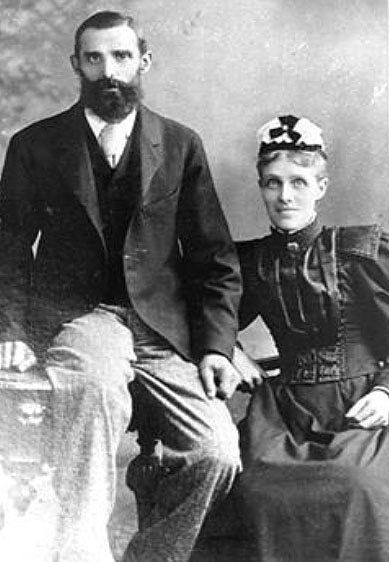 He was working full time as a booking
clerk for the Taff Railway which involved long hours and few holidays
(about three days a year). Hewell Street led off from Clive Street, one
of the major roads in Grangetown. It was the location of the site for
the Clive Street Bethel Chapel which was being built in 1875. Until this
was finished Fred and his family would attend the Bethel Chapel in Stuart
Square, Butetown, another Cardiff suburb. These local nonconformist chapels
provided much support for their working-class congregation and no doubt
provided childcare and scripture instruction for the local children. He was working full time as a booking
clerk for the Taff Railway which involved long hours and few holidays
(about three days a year). Hewell Street led off from Clive Street, one
of the major roads in Grangetown. It was the location of the site for
the Clive Street Bethel Chapel which was being built in 1875. Until this
was finished Fred and his family would attend the Bethel Chapel in Stuart
Square, Butetown, another Cardiff suburb. These local nonconformist chapels
provided much support for their working-class congregation and no doubt
provided childcare and scripture instruction for the local children.
The Bethel Chapels conducted their services in English and were built
in response to the large influx of migrant workers into the area. The
other members of the Bethel congregation were, like Fred, first generation
immigrants to Wales well aware of the need for support from the local
community. One such family, living not far away at Ferry Road, consisted
of Caroline Ann Gough and her parents Alfred and Jane, who had come to
Cardiff from a farming background in Wiltshire. In order to support the
family Alfred was earning a living by driving a horse drawn cab. Living
in close proximity within the immigrant community, being much the same
age and members of the same chapel congregation, Fred and Caroline had
much in common and would have been thrown together. They were also both
under some pressure to find a spouse; Fred to provide a mother for his
two daughters, both still under five and Caroline, approaching 30 and
with ageing parents to support.
The two - pictured left - married at the Bethel Chapel, Stuart
Square, Cardiff on 29th August 1878. Fred was 26 and his bride a year
older. The marriage produced two more children, both boys - Alfonso Rawlings(
born 1879) and Frederick Charles (b 1881). By then, Fred, his children
and wife Caroline together with her parents were living at 12 Holmesdale
Street. Fred had by now lived in Grangetown for about 10 years and was
becoming an established figure in the community. His fervent support of
the Baptist cause saw him develop as an important figure in the newly
opened Bethel Chapel in Clive Street, a focus for social equality. Alongside
of this he also became a staunch supporter of the Liberal Party. This
was the period of the Reform Act when working class men were given the
vote and could make a difference to the political status quo. It was also
the period in which the fiery Baptist preacher and radical Liberal Welsh
politician David Lloyd-George first came to prominence. It is more than
likely that Fred Denham knew David Lloyd-George considering the similarity
of their radical religious and political concerns and the size of Wales.
It is therefore quite believable when a family member later recalled a
visit by the future prime minister's wife, Margaret Lloyd George, to Caroline
Ann Denham while she was living in Wellington.
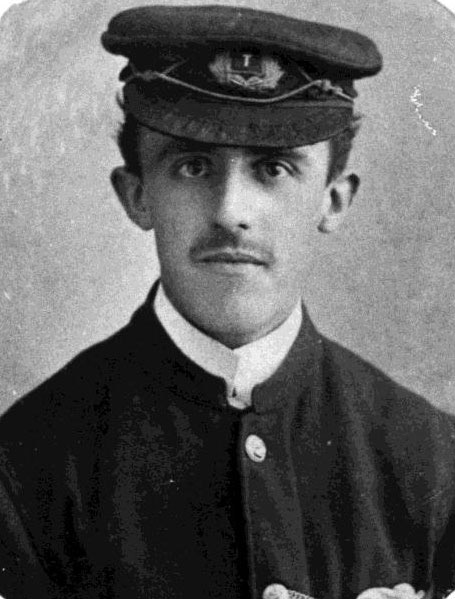 Fred was employed as a booking clerk for the Taff railway. His two sons,
when old enough, joined him in the industry, Alphonso as a horse tram
driver for the Cardiff Tram Company - where he developed an extensive
understanding of horses, their welfare and their temperament - and Frederick Charles (pictured right)
was apprenticed to Hills Dry Docks learning the skills of a ships engineer.
Hills Dry Dock and Engineering Co had been set up in the early 1880’s
and was one of many such ship repair yards in Cardiff. Fred was employed as a booking clerk for the Taff railway. His two sons,
when old enough, joined him in the industry, Alphonso as a horse tram
driver for the Cardiff Tram Company - where he developed an extensive
understanding of horses, their welfare and their temperament - and Frederick Charles (pictured right)
was apprenticed to Hills Dry Docks learning the skills of a ships engineer.
Hills Dry Dock and Engineering Co had been set up in the early 1880’s
and was one of many such ship repair yards in Cardiff.
As the family grew up in this atmosphere of rapid change and instability,
his daughters became more wayward and "played around quite a bit". The
younger daughter Mary had taken to calling herself Polly, and on a visit
to the Cardiff Exhibition in 1896, she had a pink glass engraved with
that name. She had always been considered pretty and was becoming increasingly
vain about her appearance. This vanity cannot have pleased her father,
but worse was to follow. At the end of 1898 his older daughter, Frances,
became pregnant, and the following year she went to Bristol to give birth
to twins. These indiscretions by his daughters may well have had some
influence on Fred's subsequent decision to leave Cardiff and return to
the more settled and regulating influence of his family back home in Wellington.
Or perhaps the embarrassment caused by his daughter’s escapades had some
bearing on the move? He was after all a well-known figure in the Cardiff
Baptist community.
Unrest at work may also have influenced his decision to leave Cardiff.
This was the period leading up to the Taff Vale dispute of 1900. Bitterness
was growing among the railway's employees who were demanding higher wages
and union recognition. The company on their part had no sympathy for the
workers case and when a strike was called it was smashed within two weeks
with the use of "black-leg" labour and considerable force. Fred and his
family left Cardiff just months before the strike during the simmering
dissatisfaftion when bitterness and resentment was building up amongst
the workforce. Whatever the factors that influenced the decision may have
been, Fred's mind was made up to return to the area of his birth. First
however there were the plans and arrangements to make. This move was not
just a boy running away from home as before, this time Fred was the head
of a family, with a wife, grown up children and a father-in-law to consider.
The date was finally set for Monday 25th September 1899, the Baptist Church
in Clive Street marked the occasion with a presentation after the Sunday
Service. As a token of appreciation and a reminder of his time spent in
the Cardiff Baptist community Fred was presented with a marble and slate
mantel clock. His wife, Caroline received a silver and glass fruit bowl
and her father Alfred was given a barometer. Amidst a host of farewells
and good wishes, the family prepared to depart the following day. The
move itself was accomplished with a horse and cart, which had been bought
for the purpose. The horse, called Dick, had been purchased from the Cardiff
Tram Company, who were selling off their horses in favour of the electric
tram. With their belongings all packed aboard, and Dick harnessed to the
cart, they headed for the docks, where a steam packet would take them
across the Bristol Channel to Watchet. From the harbour at Watchet to
Wellington was then only another 20 miles, so by that evening the family
were in their new home.
The two sons, Alfonso and Frederick did not travel with their parents,
but instead remained in Cardiff. Frederick was still apprenticed and stayed
at Hills Dry Dock until he was qualified as a ships engineer. Alfonso
continued to work on the trams and was courting a local girl, Ellen Honeybun.
The couple had become engaged after being introduced to each other by
her brothers, George and Ned, who were workmates of Alfonso on the Cardiff
tram system. Ellen’s father, Norris Honeybun was an uneducated labourer
who had arrived in Grangetown from Bridport, Dorset during the 1870s.
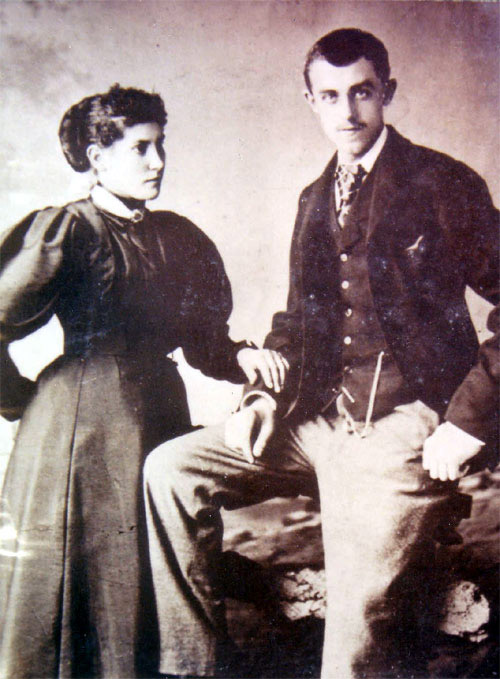 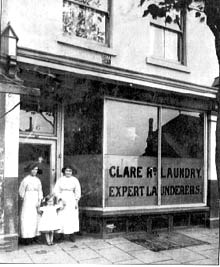 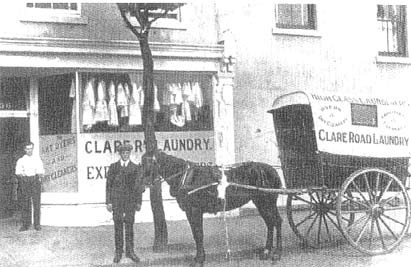
Alfonso Rawlings Denham with fiancée
Ellen Honeybun. Then two photographs of the Clare Road Laundry, where she
worked at the end of the 19th century. It was next door to Syl Evans' newsagent,
at No 56. It has since been converted to a private house. There was still
a newsagents next door until recent years, when it became a jewellers. Move
your mouse on the right hand photo for how it looks now.
Like Fred Denham, Norris had also settled in Hewell Street and found
work labouring at the docks as a coal trimmer, loading the outgoing ships.
Ellen worked as a laundress at the Clare Road steam laundry, where as
a result of an accident, she had badly damaged a hand. It had been squashed
between two heavy pressing rollers, and although no permanent loss of
movement resulted, it left the hand badly disfigured. The skin on the
back of the hand remained very thin and stretched so tight that you could
see the bones through it. Ellen, a pretty girl, was always very sensitive
to this disfigurement, and in photographs of the time she can be seen
holding her hand behind her back, or else wearing gloves. On April 16th,
1900, the couple were married at Cardiff registry Office; Alfonso was
21 and Ellen almost two years older. The witnesses, Alfred Isles and Elizabeth
Ann Way, were local and both from Ellen’s side of the family.
This marked the end of the Denham’s connection with Cardiff. Ellen,
of course, kept in contact and the children of the marriage continued
to visit their Cardiff cousins for at least 60 years. Soon after the wedding
the newlyweds left Cardiff and headed for Wellington to rejoin the others.
|
Fact sheets for more on Grangetown's Victorian growth
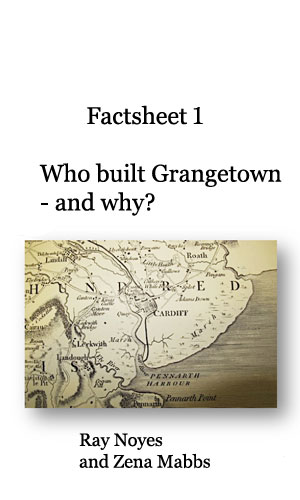
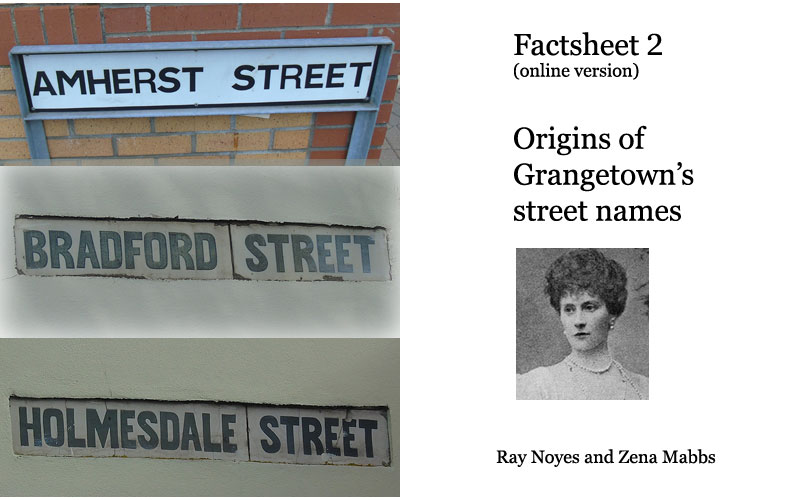
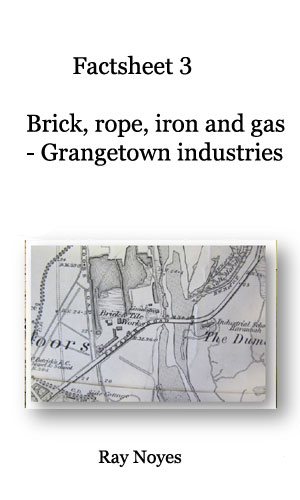
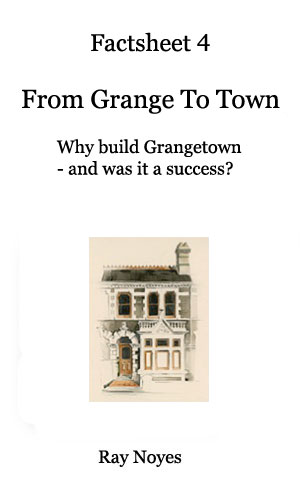
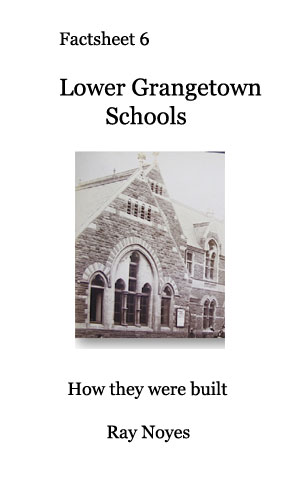
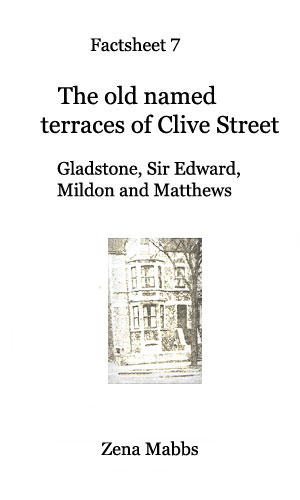
Grangetown Local History Society has produced these fact-sheets for those interested in reading more about the development of Victorian Lower Grangetown. Click on the images above to download the PDFs . The second fact sheet on the origin of street names has been reproduced instead as a webpage here, as it is too large a document to download.
The Grangetown boy
lost on Titanic
 Among
the 1,500 souls lost on Titanic on April 15th 1912 was a Grangetown-born teenager.
Among
the 1,500 souls lost on Titanic on April 15th 1912 was a Grangetown-born teenager.
Jim George Reed, just 19, had been brought up in Paget Street.
The family had moved to Penarth, a few short years before he set out
on a new life in Canada as a butcher. The passenger list showed he
probably stayed at the Platform Inn on the quayside, overlooking the
great liner's berth, before it set sail from Southampton on 10th April.
Jim had a third class ticket costing £7 5s, and was on his way to
take up a position in Toronto (Penarth Times) or Winnipeg (Western
Mail). His body was never recovered.
He was one of six children born to James George Snr, a boiler maker
- born in the docks but moving to Kent Street in Grangetown. Mr Reed
Snr died only four years after losing his second youngest son, with
the family living by this time at Cogan Hill Farm on Sully Road. There
is a plaque to Jim presented by his Sunday school class at the Trinity
Methodist Church. The Reeds had earlier lived at 7 Breacha Terrace
(Paget Street) and 100 Paget St in Grangetown.
Gabby finds Grangetown roots
TV and radio presenter
Gabby Logan took to the streets of Grangetown to research her roots - and found
a heartbreaking story about her ancestors.

She took part in the Coming Home series for BBC Wales, along with her father, former Wales football manager Terry Yorath.
She was shown her family tree and Grangetown connections, on a visit to Clive Street Baptist Church, close to where her great-great grandparents lived - in York Place and Hewell Street.
She was emotional as she uncovered details about her great, great grandmother
Clara Yorath. Clara’s husband, Cardiff docks labourer David Yorath died of TB
at just 35, leaving her with five children to bring up. Gabby’s determination
to find out what happened to Clara and her orphaned children leads her to more
heart breaking discoveries. As a mother Gabby is devastated to hear how two
of Clara’s children died of malnutrition. And the fate of Clara’s surviving
three children also makes for uncomfortable listening, involving the workhouse
among other misfortunes.
Of learning about the cruel twists in Clara’s life, Gabby says: "I felt absolutely
heartbroken. It’s beyond any comprehension of people in our society today. I
feel really drained. You don’t realise how emotionally draining it is to hear
and take on all that information. I can’t begin to imagine how she dealt with
all these deaths as a mother."
Coming Home was shown on BBC1 Wales in November 2009.
A look back at Grangetown - more than a century ago
 APRIL 1908: James W Morgan, a tramway signalman who
lived at 112 Holmesdale Street, was given a Royal Humane Society award for saving
a 17-year-old girl from drowning. Mr Morgan was on duty by the Custom House
Bridge, when he spotted Florrie Williams standing on the top of the bridge.
He could do nothing to stop her jumping, in what was reported to be a suicide
attempt. At first tried to use the long pole for removing the trolley heads
to reach her in the water. But he dropped the pole and ended up jumping in after
her in 10ft of water. The South Wales Echo reported that he was in full uniform,
wearing heavy clogs and leggings, "which much hampered him in the water." He
managed to reach her and two young men also entered the water to help him with
the rescue. Mr Morgan's colleagues in the tram company had a collection for him and he was presented with £1 11s and 6d. He came from a family of strong swimmers and his brother Henry was said to have saved several young people from the River Taff.
APRIL 1908: James W Morgan, a tramway signalman who
lived at 112 Holmesdale Street, was given a Royal Humane Society award for saving
a 17-year-old girl from drowning. Mr Morgan was on duty by the Custom House
Bridge, when he spotted Florrie Williams standing on the top of the bridge.
He could do nothing to stop her jumping, in what was reported to be a suicide
attempt. At first tried to use the long pole for removing the trolley heads
to reach her in the water. But he dropped the pole and ended up jumping in after
her in 10ft of water. The South Wales Echo reported that he was in full uniform,
wearing heavy clogs and leggings, "which much hampered him in the water." He
managed to reach her and two young men also entered the water to help him with
the rescue. Mr Morgan's colleagues in the tram company had a collection for him and he was presented with £1 11s and 6d. He came from a family of strong swimmers and his brother Henry was said to have saved several young people from the River Taff.
Another story from this month a century ago is one which the newspaper headlined
"A sad story of poverty, squalor and neglect." It tells of a time before
the welfare state and with the shadow of the workhouse still looming large.
A mother from Compton Street in Saltmead is prosecuted for child neglect, after
a policeman found three of her children in a sorry state.
The Cardiff Police Court heard that Frederick Ball was too ill to work and
Mrs Ball had pawned most of their possessions, including her clothes, to buy
food. Daughter Nellie, 11, was "weak, poorly fed, dirty and verminous" when
Sgt Whitcombe saw the family in the "dirty" two rooms where they lived
with little furniture and no fire on the grate. Wallace, five, was weak, thin,
poorly nourished, "very verminous" and only wearing a sleeveless coat, a ragged
shirt and no boots or stockings. Sister Violet, only two, was better fed but
poorly clad. The children were taken to Grangetown Police Station, where they
"ate ravenously," before they were taken to the workhouse hospital. Mrs Ball
tearfully told the court of their circumstances and when she applied for parish
relief, was told they had to go to the workhouse. A shopkeeper Mrs Barker said
how she had given her a shilling because she seemed so poor. Sgt Whitcombe said
he had seen her around, but also in a situation when she had had a drink. The
stipendary magistrate warned her that "poverty was no excuse for the insufficient
feeding and dirty condition of the children". He was to review the case
in six months time.
MAY 1908: A couple
of stories of marital issues this month. Ellen Ann Harris summonsed her estranged
husband to court for destertion and wanted a separation order. She had been married
to Benjamin Harris, a boilermaker, for 13 years, lived in Penhaved Street and
they had a child. The court heard that Mr Harris had treated his wife "in a diabolical
manner" by "staying out night after night". She turned detective after obtaining
certain information and found her husband in bed with another woman. He was told
to pay the price, at 25 shillings a week.
Another story in the Western Mail involves a tugboat owner from Amherst
Street who was after a separation order from his wife and to make an arrangement
for maintenance. "The cursed drink" loomed large, with even his mother-in-law
admitting to the court her daughter was "always, always drunk..and the children,
the poor little lambs, are allowed to go around in an awful dirty state."
JUNE 1908: One
that sticks out for this month - for all those who say things were always better
in the old days. There was trouble reported in the Echo at Grange Gardens,
as well as parks at Splott and Canton because of misbehaviour from young people,
with stones and balls being thrown. There were threats to withdraw the bands from
the bandstands "unless there was an improvement in conduct of youmg people."
"The old discipline of the schools has declined evidently," said
the paper, when "some children and young people" could pose such a
threat.
JULY 1908: A more heart-warming tale about Edwardian youth the following
month - and also the perils of playing in the river in a heatwave. There was
praise for the heroism of 13-year-old Elmer Darroch, from 35 Saltmead Road (now
Stafford Road), who dived into the Taff to save nine-year-old Clifford Baldry
from drowning, after he got out of his depth. Elmer had just passed out of Court
Road school and was on his way to work at Messrs A McLays printers in Duke Street
in the town centre.
Seeing Clifford in difficulty as he passed over the bridge, he dived from
a parapet, fully clothed, into the water. Passer-by Stephen Keely, who lived
in Court Road, went to help. Clifford was revived by Pc Albert Knight, with
the help of bystanders, and was taken to his grandmother's house in Eisteddfod
Street in Temperance Town, where he lived (approximately where the pitch of
the Millennium Stadium lies today). He came round, although was very wet and
suffering from shock. The Western Mail reported that "but for the
plucky action of the boy Darroch and the man Keely, Baldry would have been drowned."
The paper interviewed Elmer "a bright, intelligent lad", who told
his story with "becoming modesty and treated the matter somewhat lightly".
Elmer told the paper: "He was going under as I got to him - I managed to
hitch one of my feet to his bathing drawers." Finding his clothes and boots
heavy, Elmer had to let him go and Keely took over. Elmer lived with his mother,
"a hard working widow" - the rest of the family had moved to Cardiff,
where Elmer was born, from the north east of England. Two sons and two daughters
had learned to swim at school at the corporation baths.
AUGUST 1908: It
really was the "silly season" in Cardiff and nothing to report of note
for Grangetown, this month 100 years ago.
A couple of stories from around Cardiff however caught the eye. Firstly, there
was the tragedy, and remarkable story of survival, of a Cardiff sailor
following the sinking of his steamship off Germany. The Kirkwall, bound
for Cardigan, was in collision with a mystery ship near Cuxhaven. Forty men
lost their lives, including 20 seamen from Cardiff. Most of them were a multinational
crew, based in digs in Butetown. But Cardiff-based Greek sailor John Stellakis
had a remarkable escape. He held onto a plank of wood, as he drifted in the
sea for several hours before being spotted by a German boat. He was one of only
two men rescued. "I held onto a plank with the chief engineer but we were both
washed off," he told the Western Mail on his return a few days later. "I succeeded in regaining my hold but he failed and was not seen
afterwards. Then the messroom steward and the fireman held onto the same plank
but after some hours, they too were exhausted and were drowned."
Stellakis recalled: "I simply let myself drift on the plank. The skipper and
some men escaped on a small boat but that too sunk." When asked whether the
water was very cold, Athens-born Stellakis replied, "it was hell," apologising
for using such a strong expression. He was picked up by a German tug, which
also rescued a ship-mate. He lost his coat and trousers, the only thing left
was his post office savings book.
The evils of speeding motorists were highlighted in the Western Mail, under
the headline "Fast Driving in Cardiff". A chauffeur was prosecuted for dangerous driving in Queen Street
(long before it was pedestrianised, of course). Bentfield Charles Hicks forced
a number of people waiting for a tram to "jump back on the pavement" to avoid
him. Hicks was accused of reaching the dizzying speed of 16 to 18 mph. He was fined £50 - what must have felt like an extraordinary amount for the time - and banned from driving for three years!
OCTOBER 1908: The
darker side of Cardiff was getting attention, with claims that prostitution was
getting out of control. A new church-led group, called the Citizen's Movement
was formed, with Rev John Thomas of the Forward Movement its secretary, dedicated
to measures againt prostitution, illegal drinking and drunkenness.
George Bibbings, who lived in Holmesdale Street, wrote to the chief constable
and the Echo, saying it was clearly evident that there was a "brothel
colony" on the route from Tudor Street to Clarence Embankment, via Penarth
Road. Prostitutes "and their partners in vice" were using the trams,
with the full knowledge of the conductors, claimed Mr Bibbings. "The behaviour
of these gangs of women is flagrantly indecent and an extreme object lesson
in degradation." Problems started in town, with St Mary Street "unsavoury"
at nightfall. Soliciting was going on "under the noses" of police,
while daughters, wives and sisters were being accosted in Tudor Street as they
waited for their cars home. The chief constable had refused to reply to Mr Bibbings
letter and denied at the watch committee meeting that "whole streets were given
up" to brothels. The newspaper this month, as usual, carried reports of women
(and men) running disorderly houses, including a 70-year-old man in Eldon Street
(now Ninian Park Road) and Clare Poole, 24, for assisting in the management
of a disorderly house in Somerset Street - not once, but three times in three
weeks. She was fined £5. A similar case against a couple in Allerton Street
was dropped.
The paper also carried the story of a young Grangetown woman, who had married
into the notorious Agopemonite sect in Somerset. The group, which lived in a
large communal house called the "Abode of Love" had been associated with accusations
under its late founder in earlier years ranging from rape to brain-washing.
Elizabeth Link, 20 (formerly of Ludlow Street and daughter of a dockyard labourer),
had married a "highly educated" retired stockbroker's son John Read.
Elizabeth's father was now at a workhouse, while her mother was a housekeeper
in Kent Street. "Of course I was uneasy about it at first because I had read
so many dreadful things about what is supposed to go on at the Agopenmon,"
said her mother, also Elizabeth. "But I've been there many times and I
know of my own knowledge that most of what is said in the papers is untrue."
NOVEMBER 1908:
Two burglaries in Grangetown made the news. Firstly, a safe was stolen from
a house in Clare Road belonging to Edward Thomas, a turf commission agent. It
contained £130, postal orders and bank notes worth £440 and a gold
watch. Three men in their 30s were charged with the theft, after the safe was
found empty and the trail went as far as Nottingham, where one of the men tried
to pawn the watch, while another was found a little closer to home - Eldon Street
in Riverside (now Ninian Park Road) - with postal orders. In another case, a
pawnbroker's, Lewis Finsberg, was broken into in Penarth Road. Jewellery worth
more than £27 and cash was taken. A watch was found in the back yard where
one of the men, later charged, was lodging in Millicent Street. Jewellery was
also recovered from the Marl, where it was buried in the ground.
Meanwhile, a little cautionary tale from Clive Street. Postman Mr Humphries
returned home with his wife to find a gas leak. He turned off the supply but
unfortunately lit a candle to find his way into the room. There was an explosion
and fire in the front room. Luckily, neighbours helped put out the flames
and the couple escaped with minor burns, scorched clothes and singed hair.
DECEMBER 1908:
Fortune and misfortune at Christmas for two Grangetown folk. Firstly, it was
good news for Nathaniel Hounsell, who lived in Stockland Street. They didn't
have EuroMillions in 1908, but he was the lucky winner of a share in the French
lottery. Mr Hounsell had bought his share of the ticket from an acquaintance,
a marine engineer, who had in turn bought the ticket from a French sailor at
Barry docks. The total amount, with 25 francs to the pound, worked out at £3,400.
There was an appeal in the local paper to track down Mr Hounsell from the man
who held the ticket.
Less of a Merry Christmas for Alice James, of Llanbradach Street, who had
gone to police after becoming the victim of what looked like a scam for cheap
turkeys. This "highly respectable woman," as the court was told,
had answered a newspaper advert offering 8lb Christmas turkeys for 2s 6d postal
order. Unfortunately, rather than a bird, she received a letter asking for
another five shillings - or an offer to sell coupons to friends. Two Cardiff
men, including the son of an Inland Revenue official, were due to appear for
a trial in the new year.
JANUARY 1909:
A practical joke at the wedding of a couple in Saltmead Road led to the police
becoming involved. While the bride and groom were at church, a prankster tied
two ropes across the road, attached on one side to a lamppost and to the railings
on the opposite side. "A rather corpulent woman", sitting on a soap box on old
pram wheels, was then pushed down the road, and showered with confetti, as a
crowd gathered. But when the happy couple arrived back from the ceremony by
taxi cab, the driver failed to see to ropes. Thankfully, no-one was hurt but
the force against the ropes pulled down a railing, two gateways, damaged a wall
and also the front of the car.
FEBRUARY 1909:
Times have changed and some times for the better. Cardiff's always had a reputation
as a multi-racial town, so it's still a bit of a jolt to read the headline of
a story in the Western Mail from 1909. There's a story about a woman from Somerset
Street applying for a court order for the desertion of her husband, "a black
sea cook." There are details of him being jailed for running a disorderly house;
a common enough occurrence in Somerset Street in 1909! But the headline, even
for the dubious fashion of the time, is ugly. "Married a black man," it reads.
APRIL 1909: An
inquest into baby Ivan Jones, 10 months old, who died in Earl Street, the youngest
of 13 children - five still living at home. Neighbours told the inquest that
the mother had a drink problem - "I did it for the sake of the baby, because
she was always out drinking," said one, who reported her. The NSPCC inspected
but the inquest gave the mother the benefit of the doubt. The child was delicate
and had suffered fits before he died. Natural causes was recorded.
Anti-Semitism in Grangetown
in 1897

We have come across a report
from 1897 detailing anti-Semitism in north Grangetown. The worst incident
detailed in the Evening Express describes how the wife of a Jewish
tailor had her eye taken out by stone-throwing teenagers.
The paper describes the treatment "against the inoffensive Jewish
colony that has lately settled in the district". It continues:
"The opposition to the Semitic race is directed apparently by certain
lads, who, on one day, carried their persecution to such lengths by
stone-throwing- as to deprive a woman of the sight of one eye, and to
weaken the power of the other " Two 13-year-old boys William Leonard
and William Horne were charged with injuring was Amelia Roth, wife of
Judah Roth, a tailor, of 88 Saltmead Road (now Stafford Road). The court
heard that had been "a certain antagonism" had existed between the two
sections of the population in the Saltmead area. Things reached a head
on the 29th January, when a gang of boys, armed them- selves with sfones,
and "started out on an anti- Hebrew expedition." The boys knocked at
Mrs Roth's door and when she came out, they threw at her, one of the
stones taking effect on the eye. She was taken for specialist treatment
to a hospital in London. She couldn't see with the right eye,, and that
the left was getting weaker.

Grangetown history - told on DVD
A DVD telling the story of Grangetown and
the Docks was produced locally a number of years ago by Grangetown-born
Ian Malcolm, who is involved with the Cardiff Cine and Video Society and has already
produced films telling the history of Cardiff. This nearly hour-long more localised
history includes comparisons of the area then and now, stories in the words of
local people and some fascinating archive film.
Tales Of Old Grangetown naturally features some common ground, for
those familiar with the splendid "Images of Wales" books compiled over the last
10 years by Barbara Jones and Ian Clarke. It begins with a scene-setting history
of Butetown and the Docks and how Grangetown grew rapidly beyond, although its
name and earliest landmark dated back to the medieval Grange Farm. Certainly,
it was fascinating to be taken on a look inside this, thankfully, preserved
building today.
 What will appeal to those not already
familiar with local history are firstly the little nooks and crannies surviving
in the area, despite the huge changes. It's also a lesson that too many landmarks
seem to be disappearing or under threat. The most poignant moment is the plaque
marking the wartime bombing of Hollyman's Bakery in Stockland Street and the
death of 32 people. It's left to the owner of the hardware shop built on the
site to retell the story of that night in January 1941, a reminder of an event
not forgotten but of time moving on. Happier times are remembered by other locals
- the St Patrick's church pipe band, Cardiff City players when they lived a
few streets away and walked to the ground (some old colour footage at Ninian
Park is worth a look), and the small but perfectly formed business which is
Clark's Pies. There is also the curious tale of the haunting of The Grange pub
by a former landlord. Although this particularly story may lack cinematic evidence,
there is other film worth a look - including Currans munitions factory during
World War Two and some colour film of one of the earliest adventure playgrounds
on The Marl from 1970 - Grangetown was not immune to some fashion mistakes!
What will appeal to those not already
familiar with local history are firstly the little nooks and crannies surviving
in the area, despite the huge changes. It's also a lesson that too many landmarks
seem to be disappearing or under threat. The most poignant moment is the plaque
marking the wartime bombing of Hollyman's Bakery in Stockland Street and the
death of 32 people. It's left to the owner of the hardware shop built on the
site to retell the story of that night in January 1941, a reminder of an event
not forgotten but of time moving on. Happier times are remembered by other locals
- the St Patrick's church pipe band, Cardiff City players when they lived a
few streets away and walked to the ground (some old colour footage at Ninian
Park is worth a look), and the small but perfectly formed business which is
Clark's Pies. There is also the curious tale of the haunting of The Grange pub
by a former landlord. Although this particularly story may lack cinematic evidence,
there is other film worth a look - including Currans munitions factory during
World War Two and some colour film of one of the earliest adventure playgrounds
on The Marl from 1970 - Grangetown was not immune to some fashion mistakes!
These sort of films give you an appetite to delve further and perhaps take
a look at your surroundings just that bit more. The DVD occasionally has patchy
sound quality and could have done with a little less cheesy background music
in places - a personal bug-bear - but it's well overdue.
Tales Of Old Grangetown (DVD-R) is available to borrow from Cathays Local Studies Library, and it is sold in the Wellfield Bookshop, Wellfield Rd, Roath and in Rumney Post office/a shop called 'Wishful Thinking'.
|
For those interested in local history,
the Grangetown Local History
Society meets every month at Glamorgan Archives, Leckwith on the first Friday of month (2pm-4.15pm - all welcome -
bring photos along if you have them).
As
well as collecting photographs (it is happy to do copies), tbe society
is also recording audio memories from people in Grangetown in an audio
history project. The Society has also published a series of books over the years.

Grangetown History Society committee: Doug Knight, chairman; Ray Noyes, secretary Email
Alan Collier (treasurer), Grangetown
Local History Society webpage
LOCAL HISTORY RESOURCES:
Cardiff Library members can
now access Victorian newspapers online from home, including the Western
Mail from 1869 to 1899. You need to log on to the Cardiff
e-library with your membership number and password. You can also
access Ancestry.co.uk through your library membership log-in. The local studies/family history part of Cardiff library
has now been relocated to the renovated Cathays Library from 2017. It can be found on the junction of Fairoak Road and Cathays Terrace. It's open Mon-Thursday and Saturday from 9am, but closed on Friday and at lunchtimes from 1pm-2pm. There are new microfiche reading machines for old newspapers which are now integrated with the computer system, so you can also scan/ print or copy to a memory stick. The library can be reached from Grangetown on the No 8 bus (get off past the lights at the end of Crwys Road). Parking is a bit limited in the area but there is some on-road parking. Grangetown
Library in Havelock Place has a selection of Cardiff history books.
The Cardiff Museum at
the Old Library building in The Hayes houses regular local history exhibitions,
amongs other shows. It's also trying to gather memories and photos for
it's ongoing Collecting Cardiff project.
You can also research local history online with the National
Library of Wales' free Welsh newspapers online site, for pre-1910
daily and weekly papers, with an excellent search facility.
There is also the Glamorgan Archives in Leckwith, close to the new Cardiff City stadium. You can call in but it's often best to book a place in advance
- the office has old archive documents, parish and estate records, original
plans for houses and other buildings in Cardiff, as well as local
directories and maps. You can also access censuses up to 1901. There
are lockers for personal belongings, bring pencils not pens
Other useful links or interesting sites for local or family history
include the Glamorgan
Family History Society, which is useful for those both with family
connections in the area or those with just an interest in history; ancestry.co.uk
(subscription required for most services); GENUKI
Cardiff, abandoned
communities has details of old Temperance Town and Newtown in Cardiff.
If you're visiting (or even for locals), we can recommend the excellent,
informative and good value Cardiff
History and Ghost Walks, which are entertaining guided insights into
nooks and crannies of Cardiff, and Llandaff village, and tales and legends
from the past.
|
© Grangetown Community Action and webmaster 2019










 Auctioneer Thomas Clarke said he first knew Grangetown in 1859 "when it was
a dismal swamp and morass, given even the village missionary, the water wagtail
and the postman who passed it on his way to the ferry." The scene, however,
by 1873 offered a great contrast and he argued it was "capable of great
development in the future."
Auctioneer Thomas Clarke said he first knew Grangetown in 1859 "when it was
a dismal swamp and morass, given even the village missionary, the water wagtail
and the postman who passed it on his way to the ferry." The scene, however,
by 1873 offered a great contrast and he argued it was "capable of great
development in the future."






 The
north of Grangetown in particular had strong Irish and Catholic links. The
census of 1871 for Thomas Street shows us a number of Irish immigrants,
who'd settled with their families, many of them labourers with work in the
developing town. Typical is Thomas Fitzgerald, 45, a labourer with his wife
and seven children, all born locally. Neighbours include Ryans and Donovans.
There are also some brickmakers - which perhaps would tally with the brickworks
in Sloper Road. There's a pub at No 22 - The Penarth Dock run by Christopher
Griffith, 37, unusually, a Cardiff native, who lived there with his Swansea-born
wife and four young daughters. Another pub, the Grange Inn in Francis Terrace
first appears in the '61 census, run by a Daniel Francis. By 1871 it is
run by a widow from Durham. Living at 67 Francis Street (it was later renamed
Franklen Street in the 1890s, while there is also a Frances Street in Butetown,
just to confuse you!) are three families brought up in Cardiff and headed
by Irish-born labourers, John Pat Moricy, 45, his wife Mary and their six
children, aged from one to 20 - including 14-year-old Patrick, already a
labourer; John and Alice Cronin also had six children and James O'Brien
and his three young children.
The
north of Grangetown in particular had strong Irish and Catholic links. The
census of 1871 for Thomas Street shows us a number of Irish immigrants,
who'd settled with their families, many of them labourers with work in the
developing town. Typical is Thomas Fitzgerald, 45, a labourer with his wife
and seven children, all born locally. Neighbours include Ryans and Donovans.
There are also some brickmakers - which perhaps would tally with the brickworks
in Sloper Road. There's a pub at No 22 - The Penarth Dock run by Christopher
Griffith, 37, unusually, a Cardiff native, who lived there with his Swansea-born
wife and four young daughters. Another pub, the Grange Inn in Francis Terrace
first appears in the '61 census, run by a Daniel Francis. By 1871 it is
run by a widow from Durham. Living at 67 Francis Street (it was later renamed
Franklen Street in the 1890s, while there is also a Frances Street in Butetown,
just to confuse you!) are three families brought up in Cardiff and headed
by Irish-born labourers, John Pat Moricy, 45, his wife Mary and their six
children, aged from one to 20 - including 14-year-old Patrick, already a
labourer; John and Alice Cronin also had six children and James O'Brien
and his three young children.












 In winter, when they froze over,
the ponds were popular with skaters. On this particular Saturday, tragedy
struck involving a well-known local rugby player. "Dick" Davies (left)
was 26 and was a "dashing forward" for Cardiff football club. On this
particular weekend, he couldn't join his twin brother William and the
rest of the squad because of an ear injury. They had travelled all the
way north for a match at South Shields. Dick instead, visiting his mother
and sister in Allerton Street, joined up to 300 other people skating.
He was one of half a dozen men who went through thin ice, as it grew dark,
10ft from the bank and left struggling in 12ft deep water. Poles from
a building shelter were thrown across the pond for the men to reach. Spectators
used planks and linked hands to try to reach them.
In winter, when they froze over,
the ponds were popular with skaters. On this particular Saturday, tragedy
struck involving a well-known local rugby player. "Dick" Davies (left)
was 26 and was a "dashing forward" for Cardiff football club. On this
particular weekend, he couldn't join his twin brother William and the
rest of the squad because of an ear injury. They had travelled all the
way north for a match at South Shields. Dick instead, visiting his mother
and sister in Allerton Street, joined up to 300 other people skating.
He was one of half a dozen men who went through thin ice, as it grew dark,
10ft from the bank and left struggling in 12ft deep water. Poles from
a building shelter were thrown across the pond for the men to reach. Spectators
used planks and linked hands to try to reach them.





 He was working full time as a booking
clerk for the Taff Railway which involved long hours and few holidays
(about three days a year). Hewell Street led off from Clive Street, one
of the major roads in Grangetown. It was the location of the site for
the Clive Street Bethel Chapel which was being built in 1875. Until this
was finished Fred and his family would attend the Bethel Chapel in Stuart
Square, Butetown, another Cardiff suburb. These local nonconformist chapels
provided much support for their working-class congregation and no doubt
provided childcare and scripture instruction for the local children.
He was working full time as a booking
clerk for the Taff Railway which involved long hours and few holidays
(about three days a year). Hewell Street led off from Clive Street, one
of the major roads in Grangetown. It was the location of the site for
the Clive Street Bethel Chapel which was being built in 1875. Until this
was finished Fred and his family would attend the Bethel Chapel in Stuart
Square, Butetown, another Cardiff suburb. These local nonconformist chapels
provided much support for their working-class congregation and no doubt
provided childcare and scripture instruction for the local children.
 Fred was employed as a booking clerk for the Taff railway. His two sons,
when old enough, joined him in the industry, Alphonso as a horse tram
driver for the Cardiff Tram Company - where he developed an extensive
understanding of horses, their welfare and their temperament - and Frederick Charles (pictured right)
was apprenticed to Hills Dry Docks learning the skills of a ships engineer.
Hills Dry Dock and Engineering Co had been set up in the early 1880’s
and was one of many such ship repair yards in Cardiff.
Fred was employed as a booking clerk for the Taff railway. His two sons,
when old enough, joined him in the industry, Alphonso as a horse tram
driver for the Cardiff Tram Company - where he developed an extensive
understanding of horses, their welfare and their temperament - and Frederick Charles (pictured right)
was apprenticed to Hills Dry Docks learning the skills of a ships engineer.
Hills Dry Dock and Engineering Co had been set up in the early 1880’s
and was one of many such ship repair yards in Cardiff.









 Among
the 1,500 souls lost on Titanic on April 15th 1912 was a Grangetown-born teenager.
Among
the 1,500 souls lost on Titanic on April 15th 1912 was a Grangetown-born teenager.

 APRIL 1908: James W Morgan, a tramway signalman who
lived at 112 Holmesdale Street, was given a Royal Humane Society award for saving
a 17-year-old girl from drowning. Mr Morgan was on duty by the Custom House
Bridge, when he spotted Florrie Williams standing on the top of the bridge.
He could do nothing to stop her jumping, in what was reported to be a suicide
attempt. At first tried to use the long pole for removing the trolley heads
to reach her in the water. But he dropped the pole and ended up jumping in after
her in 10ft of water. The South Wales Echo reported that he was in full uniform,
wearing heavy clogs and leggings, "which much hampered him in the water." He
managed to reach her and two young men also entered the water to help him with
the rescue. Mr Morgan's colleagues in the tram company had a collection for him and he was presented with £1 11s and 6d. He came from a family of strong swimmers and his brother Henry was said to have saved several young people from the River Taff.
APRIL 1908: James W Morgan, a tramway signalman who
lived at 112 Holmesdale Street, was given a Royal Humane Society award for saving
a 17-year-old girl from drowning. Mr Morgan was on duty by the Custom House
Bridge, when he spotted Florrie Williams standing on the top of the bridge.
He could do nothing to stop her jumping, in what was reported to be a suicide
attempt. At first tried to use the long pole for removing the trolley heads
to reach her in the water. But he dropped the pole and ended up jumping in after
her in 10ft of water. The South Wales Echo reported that he was in full uniform,
wearing heavy clogs and leggings, "which much hampered him in the water." He
managed to reach her and two young men also entered the water to help him with
the rescue. Mr Morgan's colleagues in the tram company had a collection for him and he was presented with £1 11s and 6d. He came from a family of strong swimmers and his brother Henry was said to have saved several young people from the River Taff.


 What will appeal to those not already
familiar with local history are firstly the little nooks and crannies surviving
in the area, despite the huge changes. It's also a lesson that too many landmarks
seem to be disappearing or under threat. The most poignant moment is the plaque
marking the wartime bombing of Hollyman's Bakery in Stockland Street and the
death of 32 people. It's left to the owner of the hardware shop built on the
site to retell the story of that night in January 1941, a reminder of an event
not forgotten but of time moving on. Happier times are remembered by other locals
- the St Patrick's church pipe band, Cardiff City players when they lived a
few streets away and walked to the ground (some old colour footage at Ninian
Park is worth a look), and the small but perfectly formed business which is
Clark's Pies. There is also the curious tale of the haunting of The Grange pub
by a former landlord. Although this particularly story may lack cinematic evidence,
there is other film worth a look - including Currans munitions factory during
World War Two and some colour film of one of the earliest adventure playgrounds
on The Marl from 1970 - Grangetown was not immune to some fashion mistakes!
What will appeal to those not already
familiar with local history are firstly the little nooks and crannies surviving
in the area, despite the huge changes. It's also a lesson that too many landmarks
seem to be disappearing or under threat. The most poignant moment is the plaque
marking the wartime bombing of Hollyman's Bakery in Stockland Street and the
death of 32 people. It's left to the owner of the hardware shop built on the
site to retell the story of that night in January 1941, a reminder of an event
not forgotten but of time moving on. Happier times are remembered by other locals
- the St Patrick's church pipe band, Cardiff City players when they lived a
few streets away and walked to the ground (some old colour footage at Ninian
Park is worth a look), and the small but perfectly formed business which is
Clark's Pies. There is also the curious tale of the haunting of The Grange pub
by a former landlord. Although this particularly story may lack cinematic evidence,
there is other film worth a look - including Currans munitions factory during
World War Two and some colour film of one of the earliest adventure playgrounds
on The Marl from 1970 - Grangetown was not immune to some fashion mistakes!